Sony Group XBABT75 Wireless Stereo Headset User Manual XBA BT75
Sony Corporation Wireless Stereo Headset XBA BT75
User manual
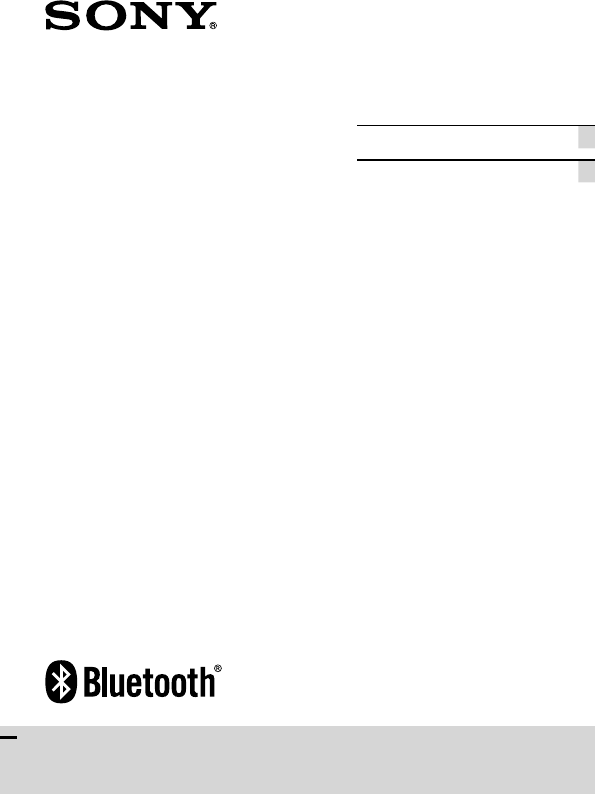
XBA-BT75 [US, ES] 4-411-333-11(1)
Wireless
Stereo Headset
4-411-333-11(1)
XBA-BT75
Operating Instructions US
Manual de instrucciones ES

XBA-BT75 [US, ES] 4-411-333-11(1)
2
US
WARNING
To reduce the risk of electrical shock, do
not open the cabinet. Refer servicing to
qualified personnel only.
Do not install the appliance in a confined
space, such as a bookcase or built-in cabinet.
Do not expose the batteries (battery pack or
batteries installed) to excessive heat such as
sunshine, fire or the like for a long time.
Excessive sound pressure from headphones
can cause hearing loss.
Information
If you have any questions about this product,
you may call:
Sony Customer Information Service Center
1-800-222-7669 or http://www.sony.com/
Declaration of Conformity
Trade Name: SONY
Model No.: BC-XBABT75
Responsible Party: Sony Electronics Inc.
Address: 16530 Via Esprillo,
San Diego, CA 92127
USA
Telephone No.: 858-942-2230
This device complies with Part 15 of the
FCC Rules. Operation is subject to the
following two conditions: (1) this device
may not cause harmful interference, and
(2) this device must accept any
interference received, including
interference that may cause undesired
operation.
You are cautioned that any changes or
modifications not expressly approved in this
manual could void your authority to operate
this equipment.
This equipment must not be co-located or
operated in conjunction with any other
antenna or transmitter.
This device complies with Part 15 of the FCC
Rules. Operation is subject to the following
two conditions: (1) this device may not cause
harmful interference, and (2) this device
must accept any interference received,
including interference that may cause
undesired operation.
This equipment complies with FCC
radiation exposure limits set forth for an
uncontrolled environment and meets the
FCC radio frequency (RF) Exposure
Guidelines in Supplement C to OET65. This
equipment has very low levels of RF energy
that are deemed to comply without testing of
specific absorption ratio (SAR).

XBA-BT75 [US, ES] 4-411-333-11(1)
3
US
Note
This equipment has been tested and found to
comply with the limits for a Class B digital
device, pursuant to Part 15 of the FCC Rules.
These limits are designed to provide
reasonable protection against harmful
interference in a residential installation. This
equipment generates, uses and can radiate
radio frequency energy and, if not installed
and used in accordance with the
instructions, may cause harmful interference
to radio communications. However, there is
no guarantee that interference will not occur
in a particular installation. If this equipment
does cause harmful interference to radio or
television reception, which can be
determined by turning the equipment off
and on, the user is encouraged to try to
correct the interference by one or more of
the following measures:
– Reorient or relocate the receiving antenna.
– Increase the separation between the
equipment and receiver.
– Connect the equipment into an outlet on
a circuit different from that to which the
receiver is connected.
– Consult the dealer or an experienced
radio/TV technician for help.
The Bluetooth word mark and logos are
owned by the Bluetooth SIG, Inc. and any
use of such marks by Sony Corporation is
under license.
Microsoft, Windows and Windows Vista are
registered trademarks or trademarks of
Microsoft Corporation in the United States
and/or other countries.
Macintosh and Mac OS are trademarks of
Apple Inc., registered in the U.S. and other
countries.
Other trademarks and trade names are those
of their respective owners.
For the customers in the USA
RECYCLING LITHIUM-ION BATTERIES
Lithium-Ion batteries are
recyclable.
You can help preserve our
environment by returning
your used rechargeable
batteries to the collection
and recycling location nearest you.
For more information regarding recycling
of rechargeable batteries, call toll free 1-
800-822-8837, or visit
http://www.rbrc.org/
Caution: Do not handle damaged or
leaking Lithium-Ion batteries.
XBA-BT75 [US, ES] 4-411-333-11(1)
4
US

XBA-BT75 [US, ES] 4-411-333-11(1)
5
US
Table Of Contents
What is Bluetooth wireless
technology? .........................6
Welcome! ..................................7
3 steps to Bluetooth function ...........8
Location and Function of
Parts ......................................9
Headset ...............................................9
Carrying Case ..................................10
Charging the unit ................. 11
Charging the headset and the
carrying case at the same
time ..............................................11
Charging the carrying case only....12
Charging the headset using the
carrying case ...............................13
Pairing ................................... 15
What is pairing? ..............................15
Pairing procedures ..........................15
Wearing the unit ................... 17
How to install the earbuds
correctly ......................................18
Indications of Bluetooth
function ............................. 19
Listening to music ................ 20
Controlling a Bluetooth connected
audio device – AVRCP .............21
Calling .................................... 22
Controlling a Bluetooth mobile
phone – HFP, HSP ....................24
Calling while playing back
music ................................. 25
Precautions ........................... 26
Troubleshooting ................... 29
Common ..........................................29
When charging ................................30
When listening to music ................30
When calling ....................................31
Initializing the unit ............... 31
Specifications ........................ 32
General .............................................32
Wireless Stereo Headset .................33
System requirements for battery
charge using USB .......................33

XBA-BT75 [US, ES] 4-411-333-11(1)
6
US
What is Bluetooth wireless technology?
Bluetooth® wireless technology is a
short-range wireless technology that
enables wireless data communication
between digital devices, such as a
computer or digital camera. Bluetooth
wireless technology operates within a
range of about 10 meters (about 30
feet).
Connecting two devices as necessary is
common, but some devices can be
connected to multiple devices at the
same time.
You do not need to use a cable for
connection, nor is it necessary for the
devices to face one another, such is the
case with infrared technology. For
example, you can use such a device in
a bag or pocket.
Bluetooth standard is an international
standard supported by thousands of
companies all over the world, and
employed by various companies
worldwide.
Communication System and
Compatible Bluetooth Profiles
of this unit
Profile is standardization of the
function for each Bluetooth device
specification. This unit supports the
following Bluetooth version and
profiles:
Communication System:
Bluetooth Specification version 3.0
Compatible Bluetooth Profiles:
– A2DP (Advanced Audio Distribution
Profile): Transmitting or receiving audio
content of high-quality.
– AVRCP (Audio Video Remote Control
Profile): Controlling A/V equipment;
pausing, stopping, or starting playback,
etc.
– HSP (Headset Profile)*: Talking on the
phone/Operating the phone.
– HFP (Hands-free Profile)*: Talking on the
phone/Operating the phone by
hands-free.
* When you use a Bluetooth mobile phone
supported by both HFP (Hands-free
Profile) and HSP (Headset Profile), set to
HFP.
Notes
To be able to use the Bluetooth function,
the Bluetooth device to be connected
requires the same profile as the unit’s.
Note also that even if the same profile
exists, devices may vary in function
depending on their specifications.
Due to the characteristic of Bluetooth
wireless technology, the sound played on
this unit is slightly delayed from the sound
played on the Bluetooth device during
talking on the telephone or listening to the
music.
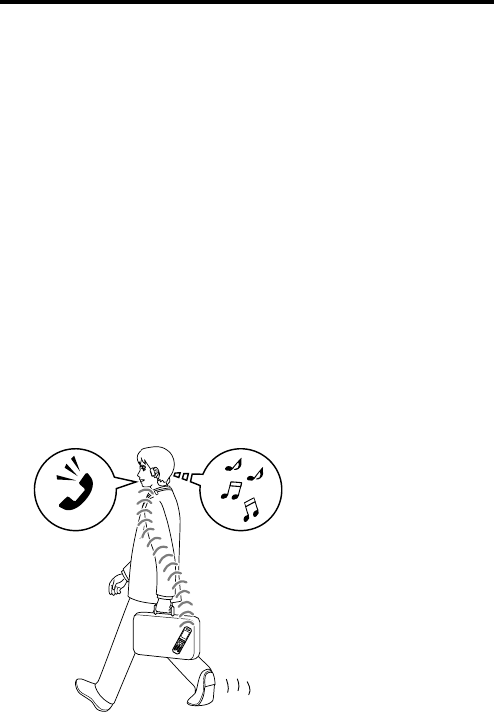
XBA-BT75 [US, ES] 4-411-333-11(1)
7
US
Welcome!
Thank you for purchasing this Sony Wireless Stereo Headset. This unit uses
Bluetooth wireless technology.
Control box-free design wireless headset.
Enjoy music wirelessly from Bluetooth Stereo-enabled music players and
mobile phones.*1
Superior noise-blocking housing design reduces sound leakage and ambient
noise.
The headset can be charged while stored in the carrying case. The carrying case
built-in battery, when fully charged, has 2.5 times capacity of the headset
battery.
Bluetooth Specification version 3.0 is adopted.
EDR (Enhanced Data Rate) 2 Mbps transmission is supported for less
interference. Under poor transmission conditions, stability is maintained by
setting “Sound Quality” to “Standard” (default setting is “High Quality”).
Hands-free calling is available for smartphones and mobile phones compatible
with Bluetooth*2.
Simple, ergonomically designed in-line remote.
Compatible with AVRCP*3. During playback, operations such as playback/
pause/skip to the next or previous song are possible.
USB rechargeable function.
Noise suppression and echo cancellation functions for superior conversation
sound quality.
For details on Bluetooth wireless technology, see page 6.
Talking on the phone Listening to music
*1 The connected Bluetooth device is
required to support A2DP.
*2 The connected Bluetooth device is
required to support HFP or HSP.
*3 The connected Bluetooth device is
required to support AVRCP.
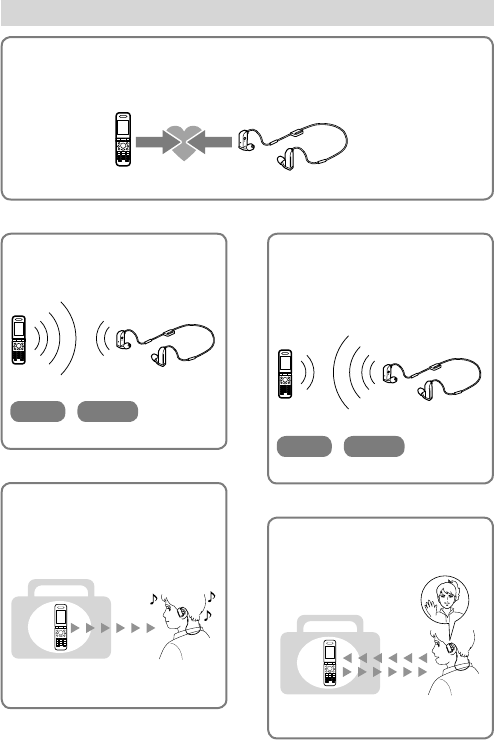
XBA-BT75 [US, ES] 4-411-333-11(1)
8
US
Calling
Listening to music
3 steps to Bluetooth function
Pairing
First, register (“pair”) a Bluetooth device (mobile phone, etc.) and this unit
with each other. Once pairing is established, there is no need for pairing again.
Bluetooth
mobile phone,
etc.
Pairing
Wireless
Stereo Headset
Page 15-16
Bluetooth connection
Operate the Bluetooth device to
make the Bluetooth connection.
Connection
A2DP AVRCP
Page 20
Bluetooth connection
When the unit is turned on, the
unit starts making the Bluetooth
connection to the recognized
mobile phone automatically.
Connection
HFP HSP
Page 22-23
Talking on the phone
You can receive a call by
operating this unit.
Voice Page 23-25
Listening to music
You can listen to music played on
the Bluetooth device.
Playback, stop, or pause is
possible from this unit.
Music
Page 20-21
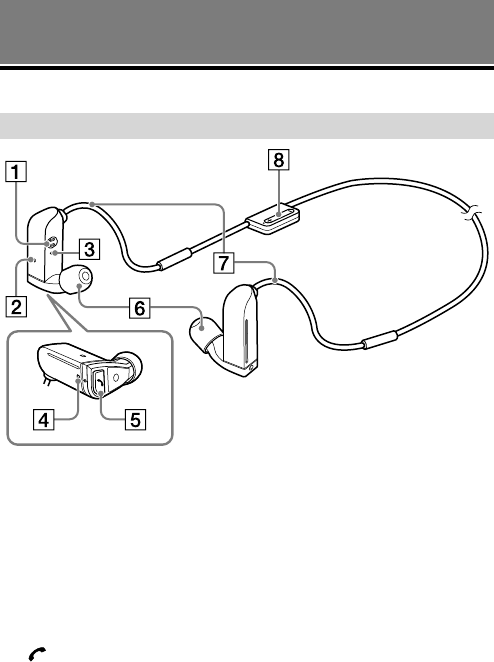
XBA-BT75 [US, ES] 4-411-333-11(1)
9
US
GETTING STARTED
Location and Function of Parts
Headset
Charging jack
Indicator (blue) / (red)
Indicates the communication
status (blue) or power status (red)
of this unit. Lights up in red while
charging.
RESET button
Microphone
(Multi function) button
Controls various functions when
turning on this unit, while calling,
or listening to music.
Earbuds
Hanger
Adjust the curve to fit your ear
profile.
+*/− button
Adjusts the volume of this unit
while calling or listening to music
by short press. Skips to the next/
previous song when listening to
music by long press.
* This button has a tactile dot for ease of use.

XBA-BT75 [US, ES] 4-411-333-11(1)
10
US
Carrying Case
Upper side Rear side
Charging indicator (red)
Lights up while charging.
Carrying case cover
Close the cover while charging the
headset.
Note
Charging will not start when the cover
is open.
Charging jack
Set the receiver marked when
charging.
USB connector
Battery status indicator
Indicates the remaining charge of
the carrying case battery by the
number of times the indicator
flashes.
Battery status check button
Press to check the remaining
charge of the carrying case
battery.
Putting the headset in the
carrying case correctly
Put the receiver marked in the left
compartment, and the one marked
in the right compartment, then close
the cover.

XBA-BT75 [US, ES] 4-411-333-11(1)
11
US
Charging the unit
The headset and carrying case contain rechargeable Lithium-Ion batteries, which
should be charged before using for the first time. The supplied carrying case is
required to charge the headset.
Charging the headset
and the carrying case at
the same time
1 Put the headset in the carrying
case.
For details, see “Putting the
headset in the carrying case
correctly” (page 10). Make sure the
headset indicator is on the right
side.
Headset indicator
Charging indicator of
carrying case
2 Close the carrying case cover.
Close firmly until you hear a click.
Note
Charging will not start when the cover is
open.
3 Connect the supplied USB cable
to the carrying case, and then
connect the other end to a
computer.
Insert the connector with mark
up.
Charging starts.
Make sure that the headset
indicator and the charging
indicator of the carrying case light
up. You can check the indicators
with the carrying case cover closed.
Charging is completed in about 2
hours* (for headset), or about 3
hours* (for carrying case), and
each indicator goes off
automatically.
* Time required for empty battery to
recharge.
Continued
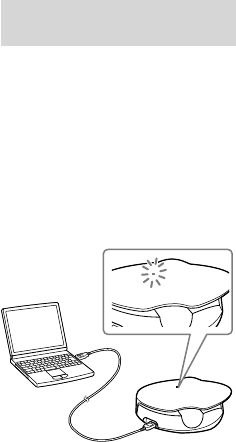
XBA-BT75 [US, ES] 4-411-333-11(1)
12
US
Notes
The headset cannot be connected to a
computer directly by USB cable.
If the headset and/or the carrying case are
not used for a long time, the indicators
may not light up when you connect the
USB cable. In this case, keep the USB cable
connected to the carrying case, and wait
until the indicators light up.
For details on the system requirements for
a personal computer to charge the battery
by USB, see “System requirements for
battery charge using USB” (page 33).
Tips
When the battery of the carrying case is
sufficiently charged, you can use the
carrying case as a battery charger for the
headset, without the need to connect to a
computer. The headset indicator lights up
while charging, and goes off when
charging is completed.
If you put the headset in the carrying case
without turning off, and close the cover,
the headset will be turned off and charging
starts automatically.
If you charge the carrying case by
connecting to an AC outlet, use the USB
Charging AC Power Adaptor AC-U501AD
(sold separately). For details, refer to the
manual supplied with the adaptor.
The headset cannot be turned on while
charging.
Charging the carrying
case only
If the carrying case is sufficiently
charged, it can be used as a battery
charger for the headset without
connecting to a computer.
1 Connect the supplied USB cable
to the carrying case, and then
connect the other end to a
computer.
Insert the connector with mark
up.
Charging starts.
Make sure that the charging
indicator of the carrying case lights
up.
Charging is completed in about 3
hours*, and the charging indicator
goes off automatically.
* Time required for empty battery to
recharge.

XBA-BT75 [US, ES] 4-411-333-11(1)
13
US
Charging the headset
using the carrying case
If the carrying case is sufficiently
charged (page 12), it can be used as a
battery charger for the headset without
connecting to a computer.
1 Put the headset in the carrying
case.
For details, see “Putting the
headset in the carrying case
correctly” (page 10).
2 Close the carrying case cover.
Close firmly until you hear a click.
Note
Charging will not start when the cover is
open.
Charging starts.
Make sure that the headset
indicator lights up. You can check
the indicator with the carrying case
cover closed.
Charging is completed in about 2
hours*, and the indicator goes off
automatically.
* Time required for empty battery to
recharge.
Caution
If this unit detects a problem while
charging, the indicator (red) may turn
off, although charging is not complete.
Check for the following causes:
– Ambient temperature is too low
(approx. 10 °C (50 °F) or lower).
– Ambient temperature is too high
(approx. 35 °C (95 °F) or higher).
– There is a problem with the battery.
Firstly, try charging the battery in a
suitable temperature range. If the
problem persists, consult your nearest
Sony dealer.
Notes
If the battery is not used for a long time,
battery may be quickly depleted, however,
after a few recharges, battery life will
improve.
When you do not use the unit for a long
time, charge the rechargeable battery at
least biannually to avoid the deterioration
of the battery.
If the battery is not used for a long time,
charging may take more time.
If the life of the built-in rechargeable
battery drops to half the normal length,
the battery should be replaced. Consult
your nearest Sony dealer for replacement
of the rechargeable battery.
Avoid exposure to temperature extremes,
direct sunlight, moisture, sand, dust or
mechanical shock. Never leave in a car
parked in the sun.
If the computer enters hibernation mode
while connected to the carrying case,
charging will not be completed properly.
Check the setting of the computer before
charging. The indicator will go off
automatically even if the computer enters
hibernation mode. Charge the unit again
in this case.
Use the supplied USB cable only, and
connect the carrying case directly to a
computer. Charging will not be completed
properly by an indirect connection, such
as via a USB hub. Continued

XBA-BT75 [US, ES] 4-411-333-11(1)
14
US
Headset usage hours*
Status Approx.
usage hours
Communication time
(including music
playback time) (up to)
3.5 hours
Standby time (up to) 400 hours
* This may vary, depending on ambient
temperature or conditions of use.
Checking the remaining
charge of the headset battery
When turning on the headset, the
indicator (blue) flashes twice, and then
the indicator (red) flashes. Check the
remaining charge by the number of
times the indicator (red) flashes.
Indicator (red) Status
3 times Full
2 times Mid
1 time Low (needs to be
charged)
When the battery is almost empty
The indicator (blue) lights up.
When the battery becomes empty, a
beep sounds and the headset will turn
off automatically.
Checking the remaining
charge of the carrying case
battery
When you press the battery status
check button on the rear side of the
carrying case, the battery status
indicator flashes. Check the remaining
charge by the number of times the
indicator flashes.
Note
You cannot check the remaining charge of
the carrying case battery while charging.
Indicator Status
3 times Full
2 times Mid
1 time Low (needs to be
charged)
When the carrying case battery is fully
charged, the headset can be fully
charged about 2.5 times*.
* This may vary, depending on ambient
temperature or conditions of use.
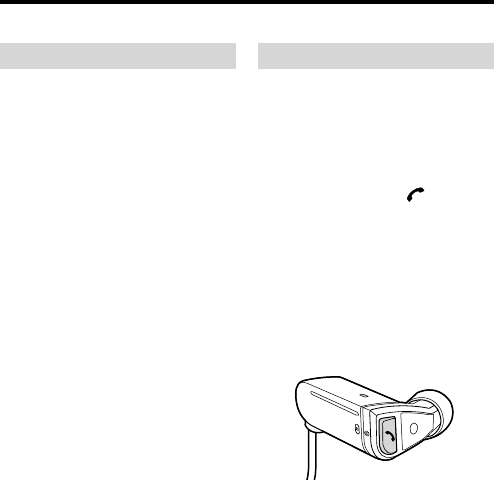
XBA-BT75 [US, ES] 4-411-333-11(1)
15
US
Pairing
What is pairing?
Bluetooth devices need to be “paired”
with each other beforehand.
Once Bluetooth devices are paired,
there is no need for pairing again,
except in the following cases:
Pairing information is deleted after
repair, etc.
When you attempt to pair with 9 or
more devices.
This unit can be paired with up to 8
devices; if a new device is paired
after 8 devices have been paired, the
device whose latest connection time
is the oldest among the 8 paired
devices is replaced by the new one.
When recognition of the unit by the
device to be connected is deleted.
This unit is initialized (page 31). All
pairing information is deleted.
Pairing procedures
Before pairing, charge the headset
(page 11, 13).
1 Place the Bluetooth device
within 1 m (3 ft) of this unit.
2 While this unit is turned off,
press and hold the (Multi
function) button until the
indicator flashes blue and red
alternately.
The unit enters pairing mode. (It
takes about 7 seconds normally to
enter pairing mode. When pairing
for the first time, or the unit is
initialized, etc., pairing takes about
2 seconds.)
Note
If pairing is not established within about
5 minutes, pairing mode will be canceled
and this unit will turn off. In this case,
start over from step 1.
Continued
XBA-BT75 [US, ES] 4-411-333-11(1)
16
US
3 Perform the pairing procedure
on the Bluetooth device to
detect this unit.
The list of detected devices appears
on the display of the Bluetooth
device. This unit is displayed as
“XBA-BT75.” If “XBA-BT75” is not
displayed, repeat from step 1.
Notes
For details, refer to the operating
instructions supplied with the
Bluetooth device.
When pairing with a Bluetooth device
that cannot display a list of detected
devices or that has no display, you
may pair the device by setting both
this unit and the Bluetooth device to
pairing mode. At this time, if passkey*
is set besides “0000” on the Bluetooth
device, pairing cannot be done with
this unit.
* Passkey may be called “Passcode,”
“PIN code,” “PIN number,” or
“Password.”
4 Select “XBA-BT75” on the
display of the Bluetooth device.
5 If passkey input is required on
the display of a Bluetooth
device, input “0000.”
Pairing is complete when the
indicator (blue) flashes slowly (or
flashes twice). A message that
pairing is complete appears on the
display of some Bluetooth devices.
Note
Passkey input may not be required
depending on the connected Bluetooth
device. For details, refer to the operating
instructions supplied with the Bluetooth
device.
6 Start the Bluetooth connection
from the Bluetooth device.
This unit memorizes the device as
the last connected device. Some
Bluetooth devices may connect
with the unit automatically when
pairing is complete.
Tips
To pair with other Bluetooth devices,
repeat steps 1 to 5 for each device.
To delete all pairing information, see
“Initializing the unit” (page 31).
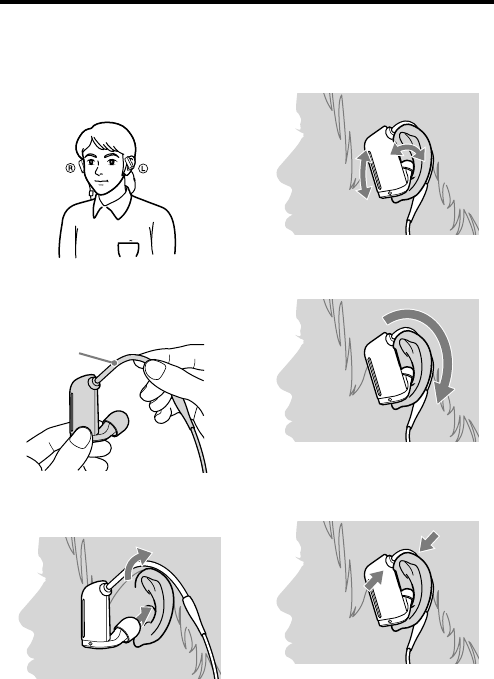
XBA-BT75 [US, ES] 4-411-333-11(1)
17
US
Wearing the unit
Wear the receiver marked in your
right ear and the one marked in
your left ear. Be sure not to twist the
hanger when wearing.
1 Hold the headset as in the
illustration, and curve the
hanger into an ear shape.
Hanger
2 Place the hanger behind the
ear.
3 Adjust the angle of the headset
to fit snugly.
4 Adjust the hanger to fit behind
the ear.
Tip
Tuck the hanger and headset toward the base
of your ear (as shown) to stabilize the
headset.
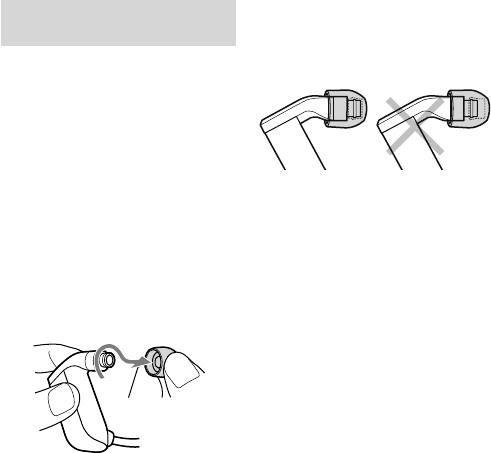
XBA-BT75 [US, ES] 4-411-333-11(1)
18
US
How to install the
earbuds correctly
If the earbuds do not fit your ears
correctly, low-bass sound may not be
heard. To enjoy better sound quality,
position the headset comfortably on
your ears, with the earbuds fitted
snugly on your ears.
If the earbuds are not a snug fit, try
another size. Confirm the size of the
earbuds by checking the color inside.
Note
The supplied earbuds are for this unit only.
Do not use with another device.
To detach an earbud
While holding the headset, carefully
peel back the earbud and twist off by
the inner sleeve.
Tip
If the earbud slips and cannot be detached,
wrap it in a dry soft cloth.
To attach an earbud
When you change the earbuds, install
them firmly on the headset to prevent
the earbud from detaching and
remaining in your ear.
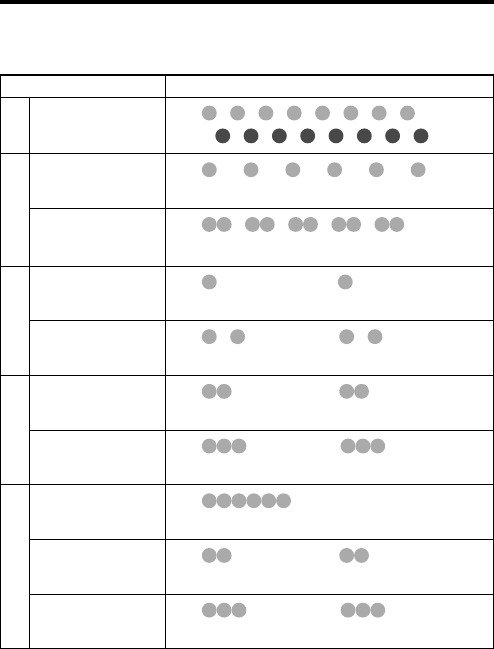
XBA-BT75 [US, ES] 4-411-333-11(1)
19
US
Indications of Bluetooth function
: Indicator (blue)
: Indicator (red)
Status Flashing patterns
Pairing
Searching ————————…
————————…
Connecting
Connectable —— —— —— —— —— …
—
Connecting — — — — —…
—
Connected
HFP/HSP or A2DP
(standby for receiving
audio signal)
————————— —————…
—
HFP/HSP and A2DP
(standby for receiving
audio signal)
— ——————— — ———…
—
Music
Listening ———————— ————…
—
Listening during standby
for telephone call ——————— ———…
—
Phone
Incoming call …
—
Talking ———————— ————…
—
Calling while playing
back music ——————— ———…
—
When the battery is almost empty
Indications of the Bluetooth function that are stated by the indicator (blue)
changes to the indicator (red).
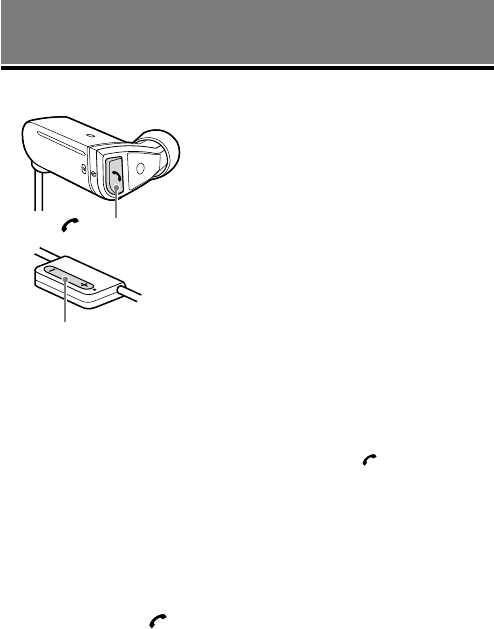
XBA-BT75 [US, ES] 4-411-333-11(1)
20
US
OPERATING THE UNIT
Listening to music
+/– button
(Multi function) button
This unit supports SCMS-T content
protection. You can enjoy music, etc.,
from a device such as a mobile phone
or portable TV that supports SCMS-T
content protection.
Check the following before operating
the unit.
– The Bluetooth device is turned on.
– Pairing of this unit and the
Bluetooth device is complete.
– The Bluetooth device supports the
transmitting music function (profile:
A2DP*).
1 While this unit is turned off,
press and hold the (Multi
function) button for about two
seconds, until the indicator
(blue) flashes twice.
The unit is turned on and the
indicator (blue) flashes slowly (or
flashes twice).
Note
After the unit is turned on, it attempts to
connect to the last connected Bluetooth
device automatically with HFP or HSP.
When not calling with this unit, do not
make the last connected Bluetooth
device ready for HFP or HSP
connection. To make or receive a call
while playing back music, see page 25.
2 Make the Bluetooth connection
(A2DP) from a Bluetooth device
to this unit.
Refer to the operating instructions
supplied with the Bluetooth device
on how to operate it.
3 Start playback on the Bluetooth
device.
Tip
A2DP Bluetooth connection can also be
performed with the (Multi function)
button, except when making a call on this
unit.
Notes
When you play music by connecting the
unit to a Bluetooth device using HSP,
sound quality will not be optimal. For
better sound, change the Bluetooth
connection to A2DP by operating the
Bluetooth device.
If this unit is turned off while an A2DP
Bluetooth connection is established,
operate the unit again from step 1 to make
the A2DP Bluetooth connection again.
* For details on profiles, see page 6.
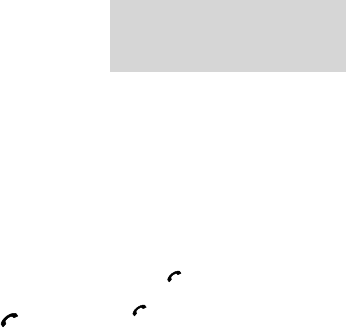
XBA-BT75 [US, ES] 4-411-333-11(1)
21
US
To adjust the volume
Quick-press the +/– button repeatedly
during playback. You can also adjust
the volume on the connected device.
Tips
Depending on the connected device, it
may also be necessary to adjust the volume
on the connected device.
Volume for calling and listening to music
can be adjusted independently. Even if you
change the volume while calling, the
volume for music playback will not
change.
To stop use
1 Terminate the Bluetooth
connection by operating the
Bluetooth device.
2 Press and hold the (Multi
function) button for about two
seconds, until the indicator
(blue) lights up.
The unit is turned off and then the
indicator goes off.
Tips
When you finish playing music, the
Bluetooth connection may terminate
automatically, depending on the Bluetooth
device.
If sound skips during playback, see “Sound
skips frequently during playback.” (page
30).
Controlling a Bluetooth
connected audio device
– AVRCP
If the Bluetooth audio device
connected with this unit supports
AVRCP, you can control it by the unit
buttons.
Note
Operation of a Bluetooth connected device
by this unit will vary depending on its
specification. Refer to the operating
instructions supplied with the Bluetooth
device.
To play back music
Press the (Multi function) button
during pause. To pause playback, press
the (Multi function) button during
playback.
To skip to the next/previous
song
Press and hold the +/– button during
playback or pause, until you hear a
chime from the unit. Press the +
button to skip to a next song, or the –
button to skip to a previous song.
To fast-forward/fast-rewind a
song*
Press and hold the +/– button during
playback or pause, until you hear the
fast-forward/rewind sound from the
unit. Press the + button to fast-forward
a song, or the – button to fast-rewind.
* This operation may skip to the next/
previous song continuously depending on
the Bluetooth device. Some Bluetooth
devices may not work.
Tip
Depending on the Bluetooth device, it may
not be possible to skip to a previous song. In
this case, press and hold the - button, and
release when a chime is heard, then press
again. It may be possible to skip.

XBA-BT75 [US, ES] 4-411-333-11(1)
22
US
Calling
+/– button
(Multi function) button
This unit supports outgoing calls from
a Bluetooth mobile phone*.
Check the following before operating
the unit.
– The Bluetooth function is active on
the mobile phone.
– Pairing of this unit and the
Bluetooth mobile phone is complete.
* Outgoing calls cannot be made directly
from this unit.
1 Press and hold the (Multi
function) button for about 2
seconds while the unit is turned
off.
The indicator (blue) flashes twice,
the unit turns on and then this unit
tries to connect to the last
Bluetooth mobile phone that was
used.
When this unit does not
connect to a Bluetooth mobile
phone automatically
1 Make the Bluetooth connection
(HFP or HSP*) from the
Bluetooth mobile phone to this
unit.
Refer to the manual supplied with
your Bluetooth mobile phone for
operation details.
The list of recognized devices
appears on the display of the
Bluetooth mobile phone. This unit
is displayed as “XBA-BT75.”
If the Bluetooth mobile phone
features both HFP and HSP, set to
HFP.
* For details on profiles, see page 6.

XBA-BT75 [US, ES] 4-411-333-11(1)
23
US
To receive a call
When an incoming call arrives, a ring
tone will be heard from the unit.
1 Press the (Multi function)
button on the unit.
The ring tone may be any one of
the following, depending on your
mobile phone.
– ring tone set on the unit
– ring tone set on the mobile
phone
– ring tone set on the mobile
phone only for Bluetooth
connection
Note
If you receive a call by pressing the
button on the Bluetooth mobile phone,
some Bluetooth mobile phones may have
handset use priority. In this case, set to
talk with the unit by pressing and
holding the (Multi function) button
for about 2 seconds, or by operating the
Bluetooth mobile phone. For details,
refer to the manual supplied with your
Bluetooth mobile phone.
To adjust the volume
Quick-press the +/– button repeatedly.
Tips
Volume adjustment is not possible when
not communicating.
Volume for calling and listening to music
can be adjusted independently. Even if you
change music volume, call volume will not
change.
To terminate a call
You can end a call by pressing the
(Multi function) button on the unit.
To stop use
1 Terminate Bluetooth
connection by the Bluetooth
mobile phone.
2 Press and hold the (Multi
function) button for about two
seconds, until the indicator
(blue) lights up.
The unit is turned off and then the
indicator (blue) goes off.

XBA-BT75 [US, ES] 4-411-333-11(1)
24
US
Controlling a Bluetooth
mobile phone – HFP,
HSP
The operation of the buttons on this
unit varies depending on your mobile
phone.
HFP or HSP is used for Bluetooth
mobile phone. Refer to the operating
instructions supplied with your
Bluetooth mobile phone on supported
Bluetooth profiles or how to operate.
HFP
Status button
Short Press Long Press
Outgoing
call*
End outgoing
call
Change call
device
Incoming call
Answer Reject
During call End call Change call
device
* Available only when using the Bluetooth
mobile phone.
HSP
Status button
Short Press Long Press
Outgoing
call*1
End outgoing
call*2
—
Incoming call
Answer —
During call End call*2Turn off
headset
*1 Available only when using a Bluetooth
mobile phone.
*2 Some functions may not be supported,
depending on the Bluetooth mobile
phone. Refer to the operating instructions
supplied with your mobile phone.

XBA-BT75 [US, ES] 4-411-333-11(1)
25
US
Calling while playing back music
The Bluetooth connection using HFP
or HSP as well as A2DP is necessary to
make a call while playing back music.
For example, to make a call using a
Bluetooth mobile phone while listening
to music on a Bluetooth compatible
music player, this unit needs to be
connected to the mobile phone using
HFP or HSP.
Make a Bluetooth connection
between this unit and the
device in use following the
procedures outlined below.
1 Make a Bluetooth connection
between this unit and the
mobile phone in use with HFP
or HSP following the
procedures outlined in
“Calling” (page 22).
2 Operate the Bluetooth device
(music player or mobile phone)
used for playing the music to
make a Bluetooth connection to
this unit using A2DP.
To receive a call while playing
back music
When an incoming call arrives, the
music pauses and the ring tone is
heard from this unit.
1 Press the (Multi function)
button and talk.
After finishing the call, press the
(Multi function) button. This unit
is switched back to music playback.
When no ring tone is heard
even if an incoming call arrives
1 Stop music playback.
2 When ringing, press the
(Multi function) button and
talk.

XBA-BT75 [US, ES] 4-411-333-11(1)
26
US
ADDITIONAL INFORMATION
Precautions
On Bluetooth communication
Bluetooth wireless technology operates
within a range of about 10 meters (about
30 feet).
Maximum communication range may
vary depending on obstacles (human body,
metal, wall, etc.) or electromagnetic
environment.
The antenna is built into the unit as
illustrated in the dotted line. The
sensitivity of the Bluetooth communication
will improve by turning the direction of
the built-in antenna to the connected
Bluetooth device.
The communication distance shortens
when the obstacles are between the
antenna of the connected device and this
unit.
Location of
built-in antenna
The following conditions may affect the
sensitivity of Bluetooth communication.
– There is an obstacle such as a human
body, metal, or wall between this unit
and Bluetooth device.
– A device using 2.4 GHz frequency, such
as a wireless LAN device, cordless
telephone, or microwave oven, is in use
near this unit.
Because Bluetooth devices and wireless
LAN (IEEE802.11b/g) use the same
frequency, microwave interference may
occur and resulting in communication
speed deterioration, noise, or invalid
connection if this unit is used near a
wireless LAN device. In such a case,
perform the following.
– Use this unit at least 10 m (about 30 ft)
away from the wireless LAN device.
– If this unit is used within 10 m (about 30
ft) of a wireless LAN device, turn off the
wireless LAN device.
– Install this unit and Bluetooth device as
near to each other as possible.
Microwaves emitting from a Bluetooth
device may affect the operation of
electronic medical devices. Turn off this
unit and other Bluetooth devices in the
following locations, as it may cause an
accident:
– where inflammable gas is present, in a
hospital, train, airplane, or a petrol
station
– near automatic doors or a fire alarm
This unit supports security capabilities
that comply with the Bluetooth standard to
provide a secure connection when the
Bluetooth wireless technology is used, but
security may not be enough depending on
the setting. Be careful when
communicating using Bluetooth wireless
technology.
We do not take any responsibility for the
leakage of information during Bluetooth
communication.
Connection with all Bluetooth devices
cannot be guaranteed.
– A device featuring Bluetooth function is
required to conform to the Bluetooth
standard specified by Bluetooth SIG,
Inc. and be authenticated.
– Even if the connected device conforms
to the above mentioned Bluetooth
standard, some devices may not be
connected or work correctly, depending
on the features or specifications of the
device.
– While talking on the phone hands free,
noise may occur, depending on the
device or communication environment.
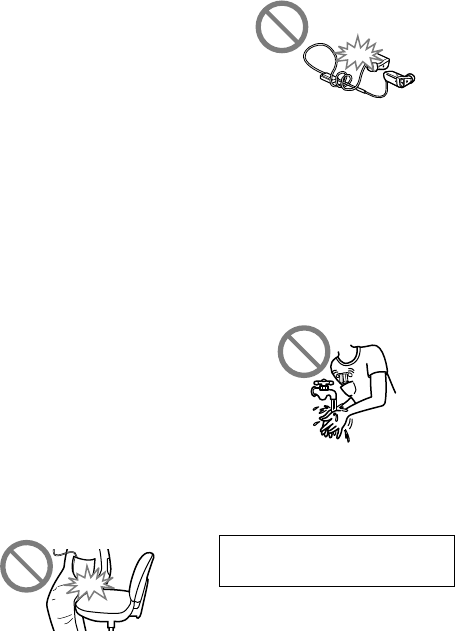
XBA-BT75 [US, ES] 4-411-333-11(1)
27
US
Depending on the device to be connected,
it may require some time to start
communication.
Note on static electricity
In particularly dry air conditions, mild
tingling may be felt on your ears. This is a
result of static electricity accumulated in the
body, and not a malfunction of the headset.
The effect can be minimized by wearing
clothes made from natural materials.
Others
Do not place this unit in a place exposed to
humidity, dust, soot or steam, subject to
direct sunlight, or in a car waiting at a
traffic signal. It may cause a malfunction.
Using the Bluetooth device may not
function on mobile phones, depending on
radio wave conditions and location where
the equipment is being used.
If you experience discomfort after using
the Bluetooth device, stop using the
Bluetooth device immediately. Should any
problem persist, consult your nearest Sony
dealer.
Listening with this unit at high volume
may affect your hearing. For traffic safety,
do not use this unit while driving or
cycling.
Do not put weight or pressure on this unit
as it may cause the unit to deform during
long storage.
Do not subject the unit to excessive shock.
Clean the unit with a soft dry cloth.
When using the unit, remember to follow
the precautions below in order to avoid
warping the cabinet or causing the unit to
malfunction.
– Make sure not to sit down with the unit
in your back pocket.
– Make sure not to put the unit into a bag
with the hanger wrapped around the
unit as accidental impact may damage
the unit.
Do not expose the unit to water. The unit
is not waterproof.
Remember to follow the precautions
below.
– Be careful not to drop the unit into a
sink or other container filled with water.
– Do not use the unit in humid locations
or bad weather, such as in the rain or
snow.
– Do not get the unit wet.
If you touch the unit with wet hands, or
put the unit in a damp article of
clothing, the unit may get wet and this
may cause a malfunction of the unit.
If you have any questions or problems
concerning this unit that are not covered
in this manual, please consult your nearest
Sony dealer.
Optional replacement earbuds can be
ordered from your nearest authorized
Sony retailer or www.sony.com.
Continued
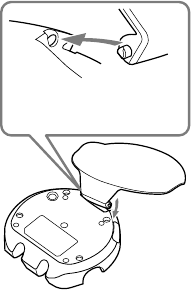
XBA-BT75 [US, ES] 4-411-333-11(1)
28
US
If the cover is detached from the
carrying case
Reattach the cover to the carrying case,
as in the illustration.
Insert the pin on one
side.
Push the other
side to engage
the cover.

XBA-BT75 [US, ES] 4-411-333-11(1)
29
US
Troubleshooting
If you run into any problems using this unit, use the following checklist and read
the product support information on our website.
Should any problem persist, consult your nearest Sony dealer.
Common
The unit is not turned on.
Charge the battery of the unit. When
you do not use the unit for a long time,
charge the rechargeable battery at least
biannually to avoid the deterioration of
the battery.
The headset cannot be turned on while
charging. Remove the USB cable and the
headset from the carrying case, and then
turn on the headset power.
Pairing cannot be done.
Bring this unit and the Bluetooth device
closer together.
Cannot make the Bluetooth
connection.
Check that this unit is turned on.
Check that the Bluetooth connecting
device is turned on and the Bluetooth
function is on.
Connection with the Bluetooth device
may not be memorized on this unit.
Make the Bluetooth connection from the
Bluetooth device to this unit soon after
pairing is complete.
This unit or Bluetooth connecting device
is in sleep mode.
The Bluetooth connection is terminated.
Make the Bluetooth connection again
(when listening to music: see page 20,
when calling: see page 22).
Distorted sound
Ensure that this unit is not receiving
interference from a wireless LAN, other
2.4 GHz wireless device, or microwave
oven.
The correspondence distance
is short. (Sound skips.)
If a device that generates
electromagnetic radiation, such as a
wireless LAN, other Bluetooth device(s),
or a microwave oven is nearby, move
away from such sources.
Point the antenna of this unit (page 26)
towards the Bluetooth device. Make sure
no obstacles block the communication.
The unit does not operate
properly.
Reset the unit. Pairing information is
not deleted by this operation.
Insert a small pin, etc., into the hole, and
push until you feel a click.

XBA-BT75 [US, ES] 4-411-333-11(1)
30
US
When charging
Charging cannot be done.
Check that the carrying case and the
computer are firmly connected by the
USB cable.
Check that the headset is placed in the
carrying case correctly.
Check that the carrying case cover is
closed firmly.
Check that the computer is turned on.
Check that the computer is not in
standby, sleep or hibernation mode.
If you charge the unit by using an AC
adaptor, make sure the recommended
USB Charging AC Power Adaptor AC-
U501AD (sold separately) is used.
Charging time is too long.
Check that the carrying case and
computer are directly connected (not via
a USB hub).
The carrying case cannot be
recognized by a computer.
The USB cable is not connected properly
to the USB port of the computer.
Connect the USB cable again.
Check that the carrying case and
computer are directly connected (not via
a USB hub).
A problem may occur with the
connected USB port of the computer.
Connect to another USB port if it is
available.
Try the USB connection procedure
again in cases other than those stated
above.
When listening to music
No sound
Bluetooth device is turned on.
A2DP Bluetooth connection is not made
between this unit and the Bluetooth
device. Make an A2DP Bluetooth
connection (page 20).
Check that music is being played back
by the Bluetooth device.
Check that the volume of the unit is not
set too low.
Turn up the volume on the connected
device if necessary.
Pair this unit and Bluetooth device again
(page 15).
Low sound level
Turn up the volume of this unit.
Turn up the volume on the connected
device if necessary.
Low sound quality
Switch the Bluetooth connection to
A2DP by operating the Bluetooth device
when HSP is set.
Sound skips frequently during
playback.
Reception condition of this unit may
have become unstable due to improper
matching of the bit-rate setting for the
music transmitted from the Bluetooth
device and the environment in which
this unit is used.*1
Terminate A2DP Bluetooth connection
by operating the Bluetooth device. While
this unit is turned off, press and hold the
– button and the (Multi function)
button for about two seconds. After the
indicator flashes red (remaining charge
indication), and once blue, release the
buttons. This unit turns on and “Sound
Quality” setting changes to “Standard.”
The setting of receivable bit rate
lowers.*2
*1 Bit rate is a numerical value which
represents data transmission volume
per second. The higher the bit rate, in
general, the better quality the sound
will be. This unit can receive high bit
rate music but sound skipping may
occur depending on the usage
environment.
*2 The above operations may not reduce
sound skip depending on the usage
environment. To return “Sound
Quality” setting to “High Quality,”
while this unit is turned off, press and
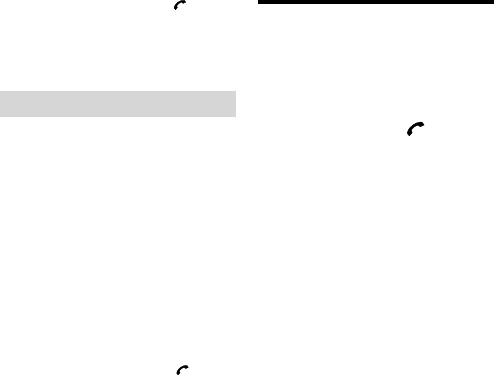
XBA-BT75 [US, ES] 4-411-333-11(1)
31
US
Initializing the unit
You can reset this unit to its default
(such as volume setting) and delete all
pairing information.
1 While this unit is turned off,
press and hold the (Multi
function) button for 15 seconds
or more.
The indicator (blue) lights up by
pressing the button for 10 seconds
or more, and flashes 4 times by
pressing for 15 seconds or more.
The unit is reset to the default. All
pairing information is deleted.
hold the + button and the (Multi
function) button for about two
seconds. After the indicator flashes
red (remaining charge indication),
and twice blue, release the buttons.
When calling
The recipient’s voice cannot be
heard.
Check that both this unit and the
Bluetooth mobile phone are turned on.
Check the connection between this unit
and the Bluetooth mobile phone. Make a
Bluetooth connection (HFP or HSP)
again (page 22).
Check that output of the Bluetooth
mobile phone is set for this unit.
Check that the volume of the unit is not
set too low.
Turn up the volume on the connected
Bluetooth mobile phone if necessary.
If you are listening to music using this
unit, stop playback, press the (Multi
function) button and talk.
Low sound from recipient
Turn up the volume of this unit.
Turn up the volume on the connected
Bluetooth mobile phone if necessary.

XBA-BT75 [US, ES] 4-411-333-11(1)
32
US
Specifications
General
Communication System
Bluetooth Specification version 3.0
Output
Bluetooth Specification Power Class 2
Maximum communication range
Line of sight approx. 10 m (30 ft)*1
Frequency band
2.4 GHz band (2.4000 GHz - 2.4835 GHz)
Modulation method
FHSS
Compatible Bluetooth Profiles*2
A2DP (Advanced Audio Distribution
Profile)
AVRCP (Audio Video Remote Control
Profile)
HFP (Hands-free Profile)
HSP (Headset Profile)
Supported Codec*3
SBC*4
Supported content protection method
SCMS-T
Transmission range (A2DP)
20 Hz - 20,000 Hz (Sampling frequency
44.1 kHz)
Included items
Headset (1)
Built-in battery carrying case (1)
Earbuds S (2), M (2), L (2)
USB cable (1)
Carrying pouch (1)
Operating instructions (this book) (1)
Recommended accessory
USB Charging AC Power Adaptor:
AC-U501AG (sold separately)
*1 The actual range will vary depending on
factors such as obstacles between devices,
magnetic fields around a microwave oven,
static electricity, reception sensitivity,
antenna’s performance, operating system,
software application, etc.
*2 Bluetooth standard profiles indicate the
purpose of Bluetooth communication
between devices.
*3 Codec: Audio signal compression and
conversion format
*4 Subband Codec

XBA-BT75 [US, ES] 4-411-333-11(1)
33
US
Wireless Stereo Headset
Power source
DC 3.7 V: Built-in lithium-ion rechargeable
battery
Mass
Approx. 21 g (0.75 oz)
Operating temperature
5 °C to 35 °C (41 °F to 95 °F)
Receiver
Type
Closed, Balanced Armature
Driver units
Balanced Armature
Frequency response
14 Hz – 24,000 Hz
Microphone
Type
MEMS
Direction characteristic
Omni directional
Effective frequency range
100 Hz – 4,000 Hz
System requirements for
battery charge using
USB
Personal Computer with pre-installed with
any of the following operating systems and
USB port:
Operating Systems
(when using Windows)
Windows® 7
Starter / Home Basic / Home Premium /
Professional / Ultimate
Windows Vista® (Service Pack 2 or later)
Home Basic / Home Premium / Business /
Ultimate
Windows® XP (Service Pack 3 or later)
Home Edition / Professional / Media Center
Edition 2004 / Media Center Edition 2005
(when using Macintosh)
Mac OS X (version.10.3 or later)
Design and specifications are subject to
change without notice.
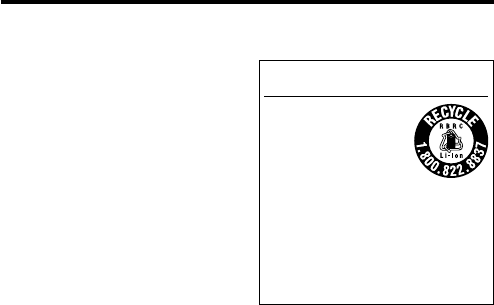
XBA-BT75 [US, ES] 4-411-333-11(1)
2
ES
ADVERTENCIA
Para evitar descargas eléctricas, no abra
la unidad. En caso de avería, solicite los
servicios de personal cualificado.
No sitúe el aparato en un espacio cerrado,
como una estantería o un armario
empotrado.
No exponga las pilas (la batería o las pilas
instaladas) a fuentes de calor excesivo como
luz solar, fuego o similar durante un período
prolongado.
Una presión acústica excesiva de los
auriculares puede provocar pérdidas
auditivas.
Información
Se le advierte de que la realización de
cambios o modificaciones no aprobados
explícitamente en este manual pueden anular
su autoridad para utilizar este equipo.
El equipo no debe colocarse ni utilizarse
junto con ninguna otra antena o transmisor.
La marca de la palabra Bluetooth y sus
logotipos son propiedad de Bluetooth SIG,
Inc. y su uso por parte de Sony Corporation
se realiza bajo licencia.
Microsoft, Windows y Windows Vista son
marcas comerciales registradas o marcas
comerciales de Microsoft Corporation en
Estados Unidos y en otros países.
Macintosh y Mac OS son marcas comerciales
de Apple Inc. registradas en Estados Unidos
y otros países.
Las demás marcas y nombres comerciales
pertenecen a sus respectivos propietarios.
Para clientes de los EE UU
RECYCLADO DE BATERIAS DE IONES
DE LITIO
Las baterías de iones de litio
son reciclables.
Usted podrá ayudar a
conservar el medio
ambiente devolviendo las
baterías usadas al punto de
reciclaje mas cercano.
Para más información sobre el reciclado
de baterías, llame al número gratuito
1-800-822-8837, o visite
http://www.rbrc.org/
Precaución: No utilice baterías de iones de
litio dañadas o con fugas.

XBA-BT75 [US, ES] 4-411-333-11(1)
3
ES
Índice
¿Qué es la tecnología
inalámbrica Bluetooth? .......4
Bienvenido ...............................5
Funcionamiento del dispositivo
Bluetooth
en solo 3 pasos ...........6
Ubicación y función de los
componentes .......................7
Auriculares .........................................7
Estuche de transporte .......................8
Carga de la unidad ...................9
Carga de los auriculares y del estuche
de transporte al mismo
tiempo ...........................................9
Carga del estuche de transporte
solamente ....................................10
Carga de los auriculares mediante el
uso del estuche de transporte ...11
Emparejamiento ................... 13
¿Qué es el emparejamiento? ..........13
Procedimientos de
emparejamiento .........................13
Utilización de la unidad ....... 15
Cómo colocar las almohadillas
correctamente.............................16
Indicaciones de la función
Bluetooth ........................... 17
Escuchar música .................... 18
Control de un dispositivo de audio
Bluetooth
conectado: perfil
AVRCP ........................................19
Realizar llamadas.................. 20
Control de un teléfono celular
Bluetooth
: HFP, HSP ................22
Realización de llamadas
durante la reproducción de
música ............................... 23
Precauciones ......................... 24
Solución de problemas ........ 27
Común ..............................................27
Durante la carga ..............................28
Al escuchar música .........................28
Durante la realización de
llamadas ......................................29
Inicialización de la unidad ... 29
Especificaciones .................... 30
Generales ..........................................30
Auriculares estéreo
inalámbricos ...............................31
Requisitos del sistema para realizar
la carga de la batería a través de
USB ..............................................31

XBA-BT75 [US, ES] 4-411-333-11(1)
4
ES
¿Qué es la tecnología inalámbrica
Bluetooth?
Bluetooth® es una tecnología
inalámbrica de corto alcance que
permite la comunicación inalámbrica
de datos entre dispositivos digitales
como, por ejemplo, un ordenador o
una cámara digital. La tecnología
inalámbrica Bluetooth funciona en un
rango de aproximadamente 10 metros.
Lo habitual es conectar dos
dispositivos, pero algunos dispositivos
admiten la conexión a varios
dispositivos a la vez.
No es necesario utilizar un cable para
realizar la conexión, ni tampoco es
necesario encarar los dispositivos entre
sí, como sucede con la tecnología de
infrarrojos. Por ejemplo, puede utilizar
los dispositivos en una bolsa o en un
bolsillo.
El estándar Bluetooth es una
convención internacional reconocida y
utilizada por miles de empresas de
todo el mundo.
Sistema de comunicación y
perfiles Bluetooth compatibles
de la unidad
Un perfil es una estandarización de la
función para cada especificación del
dispositivo Bluetooth. Esta unidad es
compatible con el perfil y la versión
Bluetooth siguientes:
Sistema de comunicación:
Especificación Bluetooth versión 3.0
Perfiles Bluetooth compatibles:
– A2DP (Advanced Audio Distribution
Profile): Transmisión o recepción de
contenido de audio de alta calidad.
– AVRCP (Audio Video Remote Control
Profile): Control del equipo de A/V;
pausa, detención o inicio de la
reproducción, etc.
– HSP (Headset Profile)*: Hablar por
teléfono/Funcionamiento del teléfono.
– HFP (Hands-free Profile)*: Hablar por
teléfono/Uso del teléfono mediante la
función de manos libres.
* Cuando utilice un teléfono móvil
Bluetooth que admita las funciones HFP
(Hands-free Profile) y HSP (Headset
Profile), ajústelo en HFP.
Notas
Para poder utilizar la función Bluetooth, el
dispositivo Bluetooth que desea conectar
debe tener el mismo perfil que la unidad.
Tenga en cuenta también que aunque
exista el mismo perfil, el funcionamiento
de los dispositivos puede variar
dependiendo de las especificaciones de
estos.
Debido a las características de la tecnología
inalámbrica Bluetooth, el sonido que se
reproduce en esta unidad sufre un ligero
retardo respecto al sonido que se
reproduce en el dispositivo Bluetooth
cuando se habla por teléfono o se escucha
música.
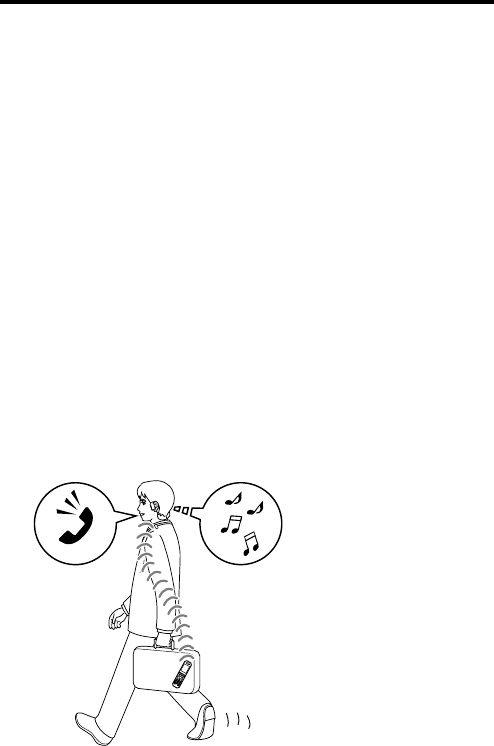
XBA-BT75 [US, ES] 4-411-333-11(1)
5
ES
Bienvenido
Gracias por haber elegido estos auriculares estéreo inalámbricos Sony. Esta
unidad utiliza la tecnología inalámbrica Bluetooth.
Auriculares inalámbricos de diseño de control sin caja.
Disfrute de música sin cables mediante reproductores de música o teléfonos
celulares equipados con Bluetooth estéreo.*1
El diseño de protección con bloqueo superior de los ruidos reduce la filtración
de sonido y el ruido ambiental.
Puede cargar los auriculares mientras están guardados en el estuche de transporte.
La batería incorporada del estuche de transporte, cuando está completamente
cargada, tiene 2,5 veces la capacidad de la batería de los auriculares.
Se adopta la especificación Bluetooth versión 3.0.
Se admite la transmisión de 2 mbps EDR (velocidad de transmisión de datos
mejorada) para tener una menor interferencia. Cuando las condiciones de
transmisión son malas, se mantiene la estabilidad al configurar “Sound Quality”
(Calidad de sonido) en “Standard” (Estándar) (la configuración
predeterminada es “High Quality” [Calidad alta]).
Las llamadas con manos libres están disponibles para teléfonos inteligentes y
teléfonos celulares compatibles con Bluetooth*2.
Control remoto en línea simple y con diseño ergonómico.
Compatible con AVRCP*3. Durante la reproducción, es posible realizar
operaciones como reproducir/pausar/saltar a la canción anterior/siguiente.
Función de recarga USB.
Funciones de supresión de ruido y de cancelación del eco para una mayor
calidad del sonido durante la conversación.
Para obtener más información sobre la tecnología inalámbrica Bluetooth, consulte la página 4.
Hablar por teléfono Escuchar música
*1 El dispositivo Bluetooth conectado debe
ser compatible con el perfil A2DP.
*2 El dispositivo Bluetooth conectado debe
ser compatible con la función HFP o
HSP.
*3 El dispositivo Bluetooth conectado debe
ser compatible con el perfil AVRCP.
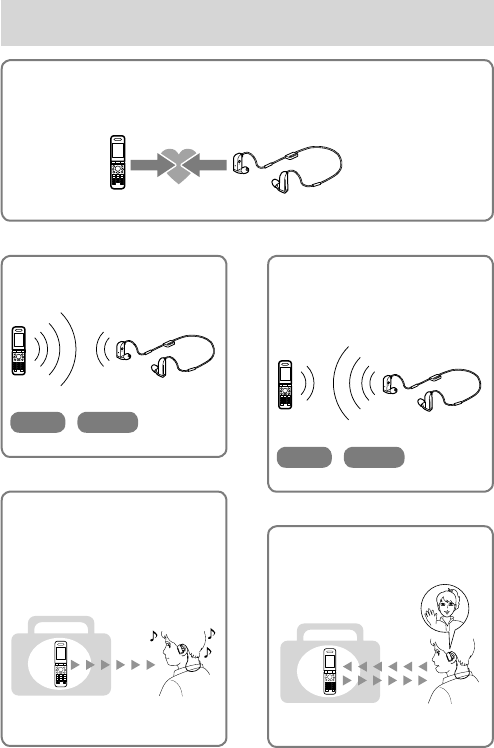
XBA-BT75 [US, ES] 4-411-333-11(1)
6
ES
Realizar llamadas
Escuchar música
Funcionamiento del dispositivo Bluetooth en solo 3
pasos
Emparejamiento
En primer lugar, registre (“empareje”) un dispositivo Bluetooth (teléfono
celular, etc.) y esta unidad entre sí. Una vez que se haya establecido el
emparejamiento, no será necesario volver a realizarlo.
Teléfonos
celulares
Bluetooth, etc.
Emparejamiento
Receptor de
Auriculares estéreo
Páginas 13-14
Conexión Bluetooth
Utilice el dispositivo Bluetooth
para realizar la conexión Bluetooth.
Conexión
A2DP AVRCP
Página 18
Conexión Bluetooth
Cuando la unidad se enciende,
esta empieza a realizar la conexión
Bluetooth con el teléfono celular
reconocido automáticamente.
Conexión
HFP HSP
Páginas 20-21
Hablar por teléfono
Puede recibir llamadas mediante
esta unidad.
Voz
Páginas 21-23
Escuchar música
Es posible escuchar música
reproducida en el dispositivo
Bluetooth.
Esta unidad permite las
operaciones de reproducción,
detención e inserción de una pausa.
Música
Páginas 18-19
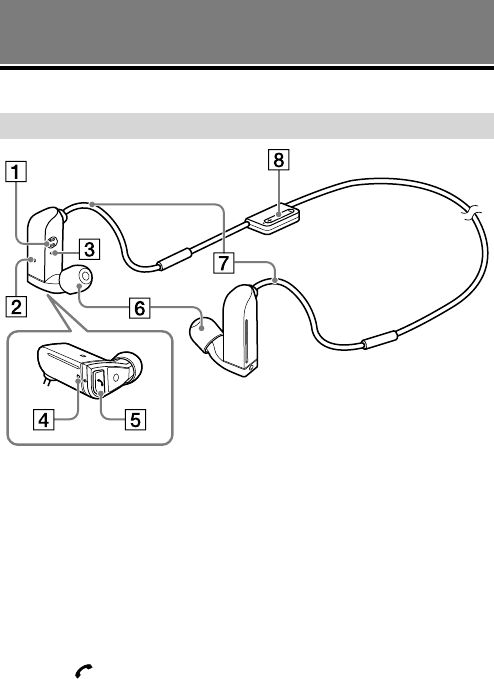
XBA-BT75 [US, ES] 4-411-333-11(1)
7
ES
PROCEDIMIENTOS INICIALES
Ubicación y función de los componentes
Auriculares
Toma para cargador
Indicador (azul)/(rojo)
Indica el estado de la
comunicación (azul) o el estado
de la alimentación (rojo) de esta
unidad. Las luces se encienden de
color rojo durante la carga.
Botón RESET
Micrófono
Botón (multifunción)
Controla varias funciones al
encender la unidad, hacer una
llamada o escuchar música.
Almohadillas
Sujetador
Ajuste la curva para que se adapte
a su oreja.
Botón +*/−
Si lo presiona de manera breve,
ajusta el volumen de esta unidad
mientras realiza una llamada o
escucha música. Si lo mantiene
presionado, salta a la canción
anterior/siguiente cuando escucha
música.
* Este botón dispone de un punto táctil para
facilitar su uso.

XBA-BT75 [US, ES] 4-411-333-11(1)
8
ES
Estuche de transporte
Parte superior Parte trasera
Indicador de carga (rojo)
Se enciende durante la carga.
Tapa del estuche de
transporte
Cierre la tapa mientras carga los
auriculares.
Nota
La carga no se iniciará si la tapa está
abierta.
Toma para cargador
Coloque el receptor marcado con
durante la carga.
Conector USB
Indicador del estado de la
batería
Indica la carga restante de la
batería del estuche de transporte
según la cantidad de veces que
parpadea el indicador.
Botón de control del estado
de la batería
Presiónelo para controlar la carga
restante de la batería del estuche
de transporte.
Colocación correcta de los
auriculares en el estuche de
transporte
Coloque el receptor marcado con
en el compartimiento izquierdo y el
receptor marcado con en el
compartimiento derecho. Luego cierre
la tapa.
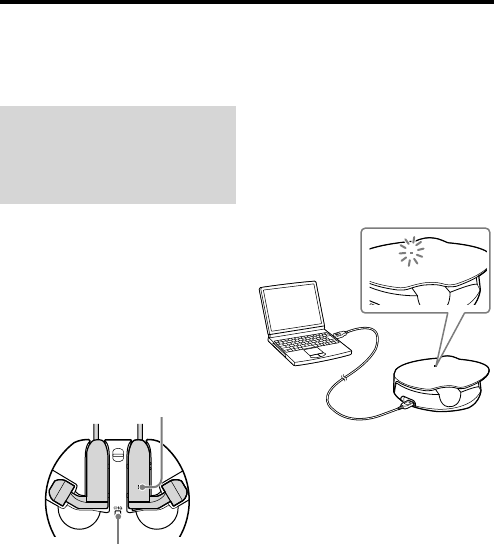
XBA-BT75 [US, ES] 4-411-333-11(1)
9
ES
Carga de la unidad
Los auriculares y el estuche de transporte contienen una batería de iones de litio
recargable, que se debe cargar antes de utilizarla por primera vez. Para cargar los
auriculares, se necesita el estuche de transporte suministrado.
Carga de los auriculares
y del estuche de
transporte al mismo
tiempo
1 Coloque los auriculares en el
estuche de transporte.
Para obtener más información,
consulte la sección “Colocación
correcta de los auriculares en el
estuche de transporte” (página 8).
Asegúrese de que el indicador de
los auriculares se encuentre en el
lado correcto.
Indicador de
los auriculares
Indicador de carga del
estuche de transporte
2 Cierre la tapa del estuche de
transporte.
Ciérrela firmemente hasta que
escuche un clic.
Nota
La carga no se iniciará si la tapa está
abierta.
3 Conecte el cable USB
suministrado al estuche de
transporte y, a continuación, el
otro extremo al ordenador.
Inserte el conector con la marca
hacia arriba.
Comienza la carga.
Asegúrese de que se enciendan el
indicador de los auriculares y el
indicador de carga del estuche de
transporte. Puede controlar los
indicadores con la tapa del estuche
de transporte cerrada.
La carga finaliza alrededor de
2 horas después* (en el caso de los
auriculares) o alrededor de 3 horas
después* (en el caso del estuche de
transporte) y cada indicador se
apaga automáticamente.
* Tiempo necesario para volver a cargar
una batería agotada.
Continúa

XBA-BT75 [US, ES] 4-411-333-11(1)
10
ES
Notas
Los auriculares no se pueden conectar a la
computadora directamente mediante el
cable USB.
Si los auriculares y/o el estuche de
transporte no se usan durante un largo
período de tiempo, es posible que no se
enciendan los indicadores cuando conecte
el cable USB. En este caso, deje el cable
USB conectado al estuche de transporte y
espere hasta que se enciendan los
indicadores.
Para obtener más información sobre los
requisitos del sistema para cargar la batería
mediante USB en un ordenador, consulte
“Requisitos del sistema para realizar la
carga de la batería a través de USB”
(página 31).
Sugerencias
Cuando la batería del estuche de
transporte está suficientemente cargada,
puede usar el estuche de transporte como
cargador de batería para los auriculares,
sin necesidad de conectarlos a una
computadora. El indicador de los
auriculares se enciende durante la carga y
se apaga cuando la carga está completa.
Si coloca los auriculares en el estuche de
transporte sin apagarlo y cierra la tapa, los
auriculares se apagarán y la carga se
iniciará automáticamente.
Si carga el estuche de transporte al
conectarlo a una toma de corriente de ca,
use el adaptador de alimentación de ca de
carga USB AC-U501AD (se vende por
separado). Para obtener más información,
consulte el manual suministrado con el
adaptador.
No es posible encender los auriculares
mientras se están cargando.
Carga del estuche de
transporte solamente
Si el estuche de transporte está
suficientemente cargado, se lo puede
usar como cargador de batería para los
auriculares sin conectarlos a la
computadora.
1 Conecte el cable USB
suministrado al estuche de
transporte y, a continuación, el
otro extremo al ordenador.
Inserte el conector con la marca
hacia arriba.
Comienza la carga.
Asegúrese de que se encienda el
indicador de carga del estuche de
transporte.
La carga se completa transcurridas
aproximadamente 3 horas* y el
indicador de carga se apaga
automáticamente.
* Tiempo necesario para volver a cargar
una batería agotada.

XBA-BT75 [US, ES] 4-411-333-11(1)
11
ES
Carga de los auriculares
mediante el uso del
estuche de transporte
Si el estuche de transporte está
suficientemente cargado (página 10),
se lo puede usar como cargador de
batería para los auriculares sin
conectarlos al ordenador.
1 Coloque los auriculares en el
estuche de transporte.
Para obtener más información,
consulte la sección “Colocación
correcta de los auriculares en el
estuche de transporte” (página 8).
2 Cierre la tapa del estuche de
transporte.
Ciérrela firmemente hasta que
escuche un clic.
Nota
La carga no se iniciará si la tapa está
abierta.
Comienza la carga.
Asegúrese de que el indicador de
los auriculares se ilumine. Puede
controlar el indicador con la tapa
del estuche de transporte cerrada.
La carga se completa transcurridas
aproximadamente 2 horas* y el
indicador se apaga
automáticamente.
* Tiempo necesario para volver a cargar
una batería agotada.
Precaución
Si la unidad detecta un problema
durante la carga, es posible que el
indicador (rojo) se apague aunque no
haya finalizado la carga.
Compruebe si se debe a las causas
siguientes:
– La temperatura ambiental es
demasiado baja (approx. 10 °C o
menor).
– La temperatura ambiental es
demasiado alta (approx. 35 °C o
mayor).
– La batería tiene un problema.
En primer lugar, intente cargar la
batería dentro de un rango de
temperatura adecuado. Si el problema
persiste, póngase en contacto con el
distribuidor Sony más cercano.
Notas
Si no se utiliza la batería durante un
período de tiempo prolongado, es posible
que la carga se agote rápidamente. Sin
embargo, después de varias recargas,
aumentará la duración.
Cuando no use la unidad durante un largo
período de tiempo, cargue la batería
recargable al menos dos veces por años
para evitar el deterioro de la batería.
Si no usa la batería durante un largo
período de tiempo, es posible que tarde
más tiempo en cargarse.
Si la vida útil de la batería recargable
incorporada disminuye hasta la mitad de
la duración normal, la batería deberá
reemplazarse. Para reemplazar la batería
recargable, póngase en contacto con el
distribuidor Sony más cercano.
Evite la exposición de la unidad a
temperaturas extremas, la luz solar directa,
la humedad, la arena, el polvo o los golpes.
No la deje nunca en un automóvil
estacionado al sol.
Continúa

XBA-BT75 [US, ES] 4-411-333-11(1)
12
ES
Si la computadora pasa al modo de
hibernación mientras está conectado al
estuche de transporte, no se completará la
carga correctamente. Compruebe la
configuración de la computadora antes de
realizar la carga. El indicador se apagará
incluso si la computadora pasa al modo de
hibernación. En ese caso, vuelva a cargar la
unidad.
Utilice sólo el cable USB suministrado y
conecte directamente el estuche de
transporte a una computadora. La carga
no se completará correctamente mediante
una conexión indirecta, como por ejemplo
a través de un concentrador USB.
Duración de los auriculares*
Estado Duración
aproximada
Tiempo de
comunicación (incluido
el tiempo de
reproducción de
música) (máximo)
3,5 horas
Tiempo en espera
(máximo)
400 horas
* Esto puede variar según la temperatura
ambiente o las condiciones de uso.
Control de la carga restante de
la batería de los auriculares
Al encender los auriculares, el
indicador (azul) parpadea dos veces y
luego parpadea el indicador (rojo).
Puede comprobar la carga restante
mediante el número de veces que
parpadea el indicador (rojo).
Indicador (rojo) Estado
3 veces Completa
2 veces Media
1 vez Baja (debe cargarla)
Cuando la batería está prácticamente
agotada
El indicador (azul) se enciende.
Cuando la batería se agota por
completo, suena un pitido y los
auriculares se apagan
automáticamente.
Control de la carga restante de
la batería del estuche de
transporte
Al presionar el botón de control del
estado de la batería ubicado en la parte
trasera del estuche de transporte,
parpadea el indicador del estado de
batería. Puede comprobar la carga
restante mediante el número de veces
que parpadea el indicador.
Nota
No puede controlar la carga restante de la
batería del estuche de transporte mientras
está cargando.
Indicador Estado
3 veces Completa
2 veces Media
1 vez Baja (debe cargarla)
Cuando la batería del estuche de
transporte está completamente
cargada, se pueden cargar
completamente los auriculares
alrededor de 2,5 veces*.
* Esto puede variar según la temperatura
ambiente o las condiciones de uso.

XBA-BT75 [US, ES] 4-411-333-11(1)
13
ES
Emparejamiento
¿Qué es el
emparejamiento?
Los dispositivos Bluetooth deben
“emparejarse” previamente entre sí.
Una vez que los dispositivos Bluetooth
se han emparejado, no es necesario
volver a hacerlo excepto en los casos
siguientes:
La información de emparejamiento
se elimina tras una reparación, etc.
Si intenta el emparejamiento con 9 o
más dispositivos.
Esta unidad se puede emparejar
hasta con 8 dispositivos; si se
empareja un noveno dispositivo,
éste reemplazará al más antiguo de
los 8 restantes.
Cuando se elimina el
reconocimiento de la unidad en el
dispositivo que desea conectar.
Se ha inicializado esta unidad
(página 29). Toda la información de
emparejamiento se elimina.
Procedimientos de
emparejamiento
Antes del emparejamiento, cargue los
auriculares (páginas 9, 11).
1 Coloque el dispositivo
Bluetooth a menos de 1 metro
de esta unidad.
2 Si la unidad está apagada,
mantenga presionado el botón
(multifunción) hasta que el
indicador parpadee de color
azul y rojo de manera
alternativa.
La unidad ingresa en el modo de
emparejamiento. (Normalmente
tarda 7 segundos en ingresar al
modo de emparejamiento. Al
realizar el emparejamiento por
primera vez o inicializar la unidad,
entre otros casos, el
emparejamiento tarda alrededor de
2 segundos).
Nota
Si el emparejamiento no se ha
establecido en unos 5 minutos, el modo
de emparejamiento se cancelará y la
unidad se apagará. En tal caso, vuelva a
comenzar desde el paso 1.
Continúa
XBA-BT75 [US, ES] 4-411-333-11(1)
14
ES
3 Realice el procedimiento de
emparejamiento en el
dispositivo Bluetooth para que
detecte esta unidad.
La lista de los dispositivos
detectados aparecerá en la pantalla
del dispositivo Bluetooth. Esta
unidad aparece como “XBA-BT75”.
Si no se muestra “XBA-BT75”,
repita el procedimiento desde el
paso 1.
Notas
Para obtener más información,
consulte el manual de instrucciones
que se suministra junto con el
dispositivo Bluetooth.
Cuando realice el emparejamiento con
un dispositivo Bluetooth que no pueda
mostrar una lista de dispositivos
detectados o no disponga de pantalla,
puede emparejar el dispositivo
mediante el ajuste de la unidad y del
dispositivo Bluetooth en modo de
emparejamiento. En este momento, si
la clave de acceso* no está ajustada en
“0000” en el dispositivo Bluetooth, no
es posible emparejar la unidad.
* La clave de acceso puede denominarse
“contraseña”, “código PIN”, “número
PIN” o “código de acceso”.
4 Seleccione “XBA-BT75” en la
pantalla del dispositivo
Bluetooth.
5 Si se solicita la introducción de
una clave de acceso en la
pantalla del dispositivo
Bluetooth, introduzca “0000.”
El emparejamiento finaliza cuando
el indicador (azul) parpadea
lentamente (o parpadea dos veces).
En la pantalla de algunos
dispositivos Bluetooth aparece un
mensaje que indica que ha
finalizado el emparejamiento.
Nota
En función del dispositivo Bluetooth
conectado, es posible que no se requiera
el ingreso de una clave de acceso. Para
obtener más información, consulte el
manual de instrucciones que se
suministra junto con el dispositivo
Bluetooth.
6 Inicie la conexión Bluetooth
desde el dispositivo Bluetooth.
La unidad memoriza este
dispositivo como el último al que
se ha conectado. Es posible que
algunos dispositivos Bluetooth se
conecten automáticamente a esta
unidad al finalizar el
emparejamiento.
Sugerencias
Para realizar un emparejamiento con otros
dispositivos Bluetooth, repita los pasos del
1 al 5 para cada dispositivo.
Para eliminar toda la información de
emparejamiento, consulte “Inicialización
de la unidad” (página 29).
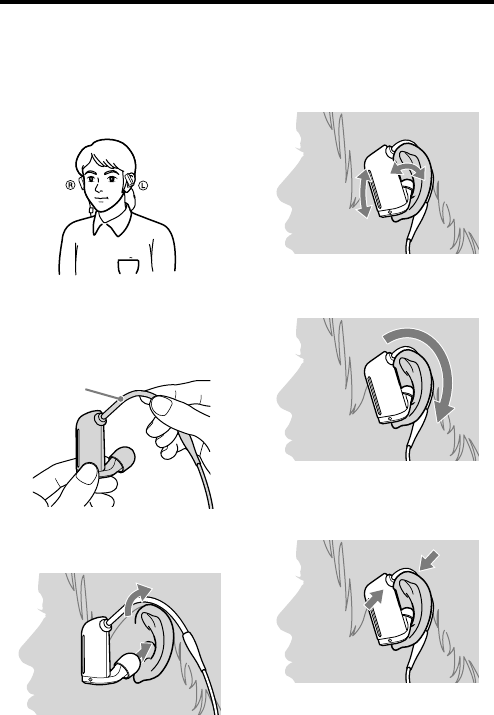
XBA-BT75 [US, ES] 4-411-333-11(1)
15
ES
Utilización de la unidad
Póngase el receptor con la marca en
la oreja derecha y el receptor con la
marca en la izquierda. Asegúrese de
no torcer el sujetador cuando lo esté
usando.
1 Sostenga los auriculares como
se muestra en la imagen y
doble el sujetador en forma de
oreja.
Sujetador
2 Coloque el sujetador detrás de
la oreja.
3 Ajuste el ángulo de los
auriculares para que le ajusten
bien.
4 Ajuste el sujetador para que se
acomode detrás de la oreja.
Sugerencia
Coloque el sujetador y los auriculares en la
base de la oreja (tal como se muestra en la
imagen) para estabilizar los auriculares.
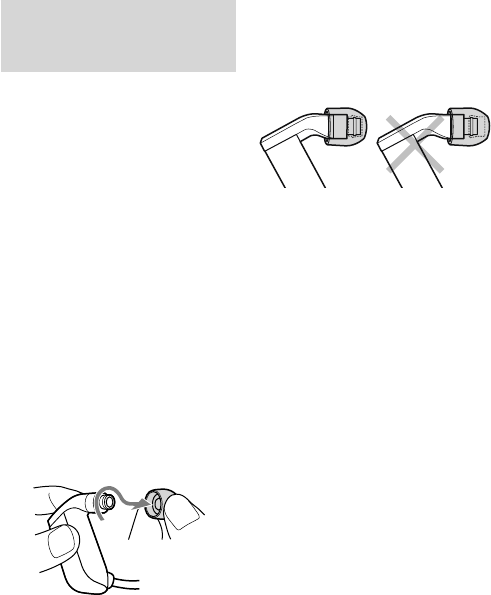
XBA-BT75 [US, ES] 4-411-333-11(1)
16
ES
Cómo colocar las
almohadillas
correctamente
Si las almohadillas no se adaptan
correctamente a sus orejas, es posible
que no escuche los sonidos graves
bajos. Para disfrutar una mejor calidad
de sonido, coloque los auriculares en
las orejas de manera que le queden
cómodos, de forma tal que las
almohadillas se ajusten bien a las
orejas.
Si las almohadillas no están bien
ajustadas, intente con otro tamaño.
Para comprobar si el tamaño de las
almohadillas es correcto, controle el
color que tienen en la parte interior.
Nota
Las almohadillas suministradas son sólo para
esta unidad. No las utilice con otro
dispositivo.
Para quitar una almohadilla
Mientras sostiene los auriculares,
desprenda suavemente la almohadilla
y sepárela retorciéndola por la parte
interior.
Sugerencia
Si la almohadilla se resbala y no la puede
separar, envuélvala en un paño suave y seco.
Para colocar una almohadilla
Cuando cambie las almohadillas,
colóquelas firmemente en los
auriculares para evitar que la
almohadilla se separe y se quede en la
oreja.

XBA-BT75 [US, ES] 4-411-333-11(1)
17
ES
Indicaciones de la función Bluetooth
: Indicador (azul)
: Indicador (rojo)
Estado Patrones de parpadeo
Empareja-
miento
Búsqueda ————————…
————————…
En proceso de
conexión
Conexiones disponibles —— —— —— —— —— …
—
En proceso de conexión — — — — —…
—
Conexión
establecida
HFP/HSP o A2DP
(en espera para recibir
señal de audio)
————————— —————…
—
HFP/HSP y A2DP
(en espera para recibir
señal de audio)
— ——————— — ———…
—
Música
Escucha ———————— ————…
—
Escucha durante tiempo
de espera para llamada de
teléfono
——————— ———…
—
Teléfono
Llamada entrante …
—
Conversación ———————— ————…
—
Realización de llamadas
durante la reproducción
de música
——————— ———…
—
Cuando la batería está prácticamente agotada
Las indicaciones de la función Bluetooth que muestra el indicador (azul) cambian
al indicador (rojo).
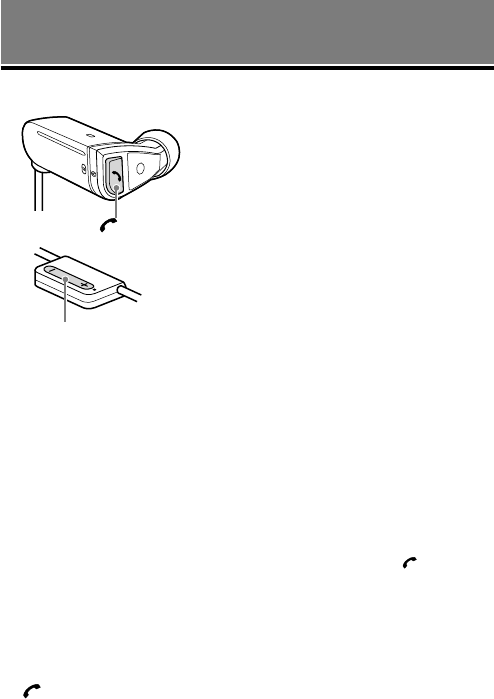
XBA-BT75 [US, ES] 4-411-333-11(1)
18
ES
USO DE LA UNIDAD
Escuchar música
Botón +/–
Botón (multifunción)
Esta unidad es compatible con la
protección de contenido SCMS-T.
Puede disfrutar de la música desde un
dispositivo como un teléfono celular o
un televisor portátil compatible con la
protección de contenido SCMS-T.
Antes de utilizar la unidad, compruebe
los puntos siguientes.
– El dispositivo Bluetooth está
encendido.
– Ha finalizado el emparejamiento de
esta unidad y del dispositivo
Bluetooth.
– El dispositivo Bluetooth admite la
función de transmisión de música
(perfil: A2DP*).
1 Si la unidad está apagada,
mantenga presionado el botón
(multifunción) durante
alrededor de dos segundos
hasta que el indicador
parpadee dos veces (de color
azul).
La unidad se enciende y el
indicador (azul) parpadea
lentamente (o parpadea dos veces).
Nota
Una vez activada la unidad, ésta intenta
conectarse automáticamente al último
dispositivo Bluetooth al que se conectó
con HFP o HSP.
Cuando no realice llamadas con la
unidad, no deje el último dispositivo
Bluetooth conectado preparado para
realizar una conexión HFP o HSP. Para
realizar o recibir llamadas mientras
escucha música, consulte la página 23.
2 Realice la conexión Bluetooth
(A2DP) desde un dispositivo
Bluetooth a esta unidad.
Consulte el manual de
instrucciones suministrado con el
dispositivo Bluetooth para saber
cómo controlarlo.
3 Inicie la reproducción del
dispositivo Bluetooth.
Sugerencia
La conexión Bluetooth de A2DP también se
puede realizar con el botón
(multifunción), excepto cuando se haga una
llamada en esta unidad.
Notas
Cuando reproduzca música mediante la
conexión de la unidad a un dispositivo
Bluetooth con HSP, la calidad del sonido
no será óptima. Para una mejor calidad de
sonido, cambie la conexión Bluetooth a
A2DP utilizando el dispositivo Bluetooth.
Si se apaga la unidad cuando se ha
establecido una conexión Bluetooth A2DP,
vuelva a ponerla en funcionamiento desde
el paso 1 para realizar de nuevo la
conexión Bluetooth A2DP.

XBA-BT75 [US, ES] 4-411-333-11(1)
19
ES
* Para obtener más información sobre los
perfiles, consulte la página 4.
Para ajustar el volumen
Presione rápida y reiteradamente el
botón +/– durante la reproducción.
También puede ajustar el volumen del
dispositivo conectado.
Sugerencias
En función del dispositivo que conecte, es
posible que también deba ajustar el
volumen en dicho dispositivo.
Es posible ajustar el volumen para realizar
llamadas y escuchar música de forma
independiente. Aunque modifique el
volumen mientras realiza una llamada, el
volumen de la reproducción de música no
variará.
Para detener el uso
1 Para finalizar la conexión
Bluetooth haga funcionar el
dispositivo Bluetooth.
2 Mantenga presionado el botón
(multifunción) durante
alrededor de dos segundos,
hasta que se encienda el
indicador (azul).
La unidad se apagará y luego
también se apagará el indicador.
Sugerencias
Cuando finalice la reproducción de
música, es posible que la conexión
Bluetooth finalice automáticamente, según
el dispositivo Bluetooth que se utilice.
Si se producen saltos en el sonido durante
la reproducción, consulte la sección “Se
producen saltos frecuentes en el sonido
durante la reproducción” (página 28).
Control de un dispositivo
de audio Bluetooth
conectado: perfil AVRCP
Si el dispositivo de audio Bluetooth
conectado con esta unidad admite
AVRCP, podrá controlarlo mediante
los botones de la unidad.
Nota
La utilización del dispositivo Bluetooth
conectado variará dependiendo de las
especificaciones. Consulte el manual de
instrucciones que se suministra junto con el
dispositivo Bluetooth.
Para reproducir música
Presione el botón (multifunción)
durante la pausa. Para pausar la
reproducción, presione el botón
(multifunción) durante la
reproducción.
Para ir a la canción anterior/
siguiente
Mantenga presionado el botón +/–
durante la reproducción o la pausa,
hasta que escuche un sonido de la
unidad. Presione el botón + para saltar
a la canción siguiente o el botón – para
saltar a la canción anterior.
Para avanzar/rebobinar rápido
una canción*
Mantenga presionado el botón +/– durante
la reproducción o la pausa, hasta que
escuche el sonido de avance/rebobinado
rápido de la unidad. Presione el botón +
para avanzar rápidamente una canción o el
botón – para rebobinar rápidamente.
*
Esta operación puede saltar a la canción
siguiente/anterior continuamente según el
dispositivo Bluetooth. Es posible que algunos
dispositivos Bluetooth no funcionen.
Sugerencia
Según el dispositivo Bluetooth, es posible que
no se pueda saltar a la canción anterior. En
este caso, mantenga presionado el botón - y
suéltelo cuando escuche un sonido; luego
vuelva a presionarlo. Es posible que se pueda
saltar de canción.

XBA-BT75 [US, ES] 4-411-333-11(1)
20
ES
Realizar llamadas
Botón +/–
Botón (multifunción)
Esta unidad admite llamadas salientes
de un teléfono celular Bluetooth*.
Antes de utilizar la unidad, compruebe
los puntos siguientes.
– La función Bluetooth está activada
en el teléfono celular.
– Ha finalizado el emparejamiento de
esta unidad y del teléfono celular
Bluetooth.
* Las llamadas salientes no se pueden hacer
directamente desde esta unidad.
1 Con la unidad apagada,
mantenga presionado el botón
(multifunción) durante
aproximadamente 2 segundos.
El indicador (azul) parpadea dos
veces, la unidad se enciende y, a
continuación, esta intenta
conectarse automáticamente al
último teléfono celular Bluetooth
que se usó.
Si la unidad no se conecta a un
teléfono celular Bluetooth
automáticamente
1 Realice la conexión Bluetooth
(HFP o HSP*) desde el teléfono
celular Bluetooth a esta unidad.
Para obtener más información
sobre el procedimiento a seguir,
consulte el manual suministrado
con el teléfono celular Bluetooth.
La lista de dispositivos reconocidos
aparecerá en la pantalla del
teléfono celular Bluetooth. Esta
unidad aparece como
“XBA-BT75”.
Si el teléfono celular Bluetooth
acepta tanto la función HFP como
la función HSP, configúrelo en la
función HFP.
* Para obtener más información sobre
los perfiles, consulte la página 4.

XBA-BT75 [US, ES] 4-411-333-11(1)
21
ES
Para recibir una llamada
Al recibir una llamada entrante, oirá
un tono de llamada de la unidad.
1 Presione el botón
(multifunción) de la unidad.
El tono de llamada puede ser
cualquiera de los siguientes, según
su teléfono celular.
– tono de llamada ajustado en la
unidad
– tono de llamada ajustado en el
teléfono celular
– tono de llamada ajustado en el
teléfono celular solo para la
conexión Bluetooth
Nota
Si presiona el botón del teléfono celular
Bluetooth
para recibir una llamada,
tenga en cuenta que algunos teléfonos
Bluetooth
pueden tener activada la
prioridad para utilizar el auricular. En
este caso, mantenga presionado el botón
(multifunción) durante unos 2
segundos para ajustar la opción de
hablar con la unidad o realice el ajuste
desde el teléfono celular Bluetooth. Para
obtener más información, consulte el
manual suministrado con el teléfono
celular Bluetooth.
Para ajustar el volumen
Presione rápida y reiteradamente el
botón +/–.
Sugerencias
No es posible ajustar el volumen cuando
no se realizan comunicaciones.
Es posible ajustar el volumen para realizar
llamadas y escuchar música de forma
independiente. Aunque cambie el volumen
de la música, el volumen de la llamada no
cambiará.
Para finalizar una llamada
Para finalizar una llamada puede
presionar el botón (multifunción)
de la unidad.
Para detener el uso
1 Termine la conexión Bluetooth
en el teléfono celular
Bluetooth
.
2 Mantenga presionado el botón
(multifunción) durante
alrededor de dos segundos,
hasta que se encienda el
indicador (azul).
La unidad se apagará y luego
también se apagará el indicador
(azul).

XBA-BT75 [US, ES] 4-411-333-11(1)
22
ES
Control de un teléfono
celular Bluetooth: HFP,
HSP
El uso de los botones de esta unidad
varía dependiendo del teléfono celular
que utilice.
La función HFP o HSP se usa para el
teléfono celular Bluetooth. Consulte el
manual de instrucciones suministrado
junto con el teléfono celular Bluetooth
para obtener información sobre los
perfiles Bluetooth compatibles y su
funcionamiento.
HFP
Estado botón
Presionar Mantener
presionado
Llamada
saliente*
Fin de la
llamada
saliente
Cambio de
dispositivo de
llamada
Llamada
entrante
Responde a la
llamada
Rechaza la
llamada
Durante la
llamada
Finaliza la
llamada
Cambio de
dispositivo de
llamada
* Disponible sólo cuando se usa el teléfono
celular Bluetooth.
HSP
Estado botón
Presionar Mantener
presionado
Llamada
saliente*1
Fin de la
llamada
saliente*2
—
Llamada
entrante
Responde a la
llamada
—
Durante la
llamada
Finaliza la
llamada*2
Apaga los
auriculares
*1 Disponible sólo cuando se usa el teléfono
celular Bluetooth.
*2 Es posible que algunas funciones no sean
compatibles en función del teléfono
celular Bluetooth. Consulte las
instrucciones de uso suministradas con su
teléfono celular.
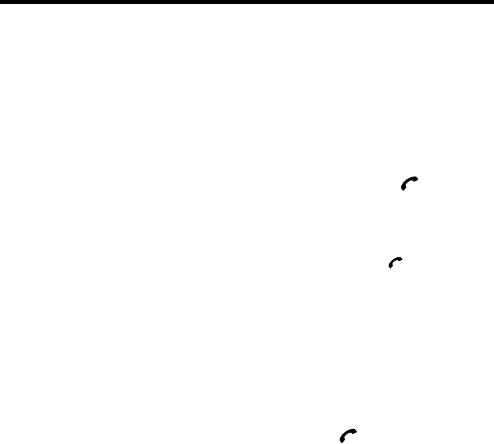
XBA-BT75 [US, ES] 4-411-333-11(1)
23
ES
Realización de llamadas durante la
reproducción de música
La conexión Bluetooth con HFP o
HSP, así como con A2DP, es necesaria
para realizar una llamada mientras
reproduce música.
Por ejemplo, para realizar una llamada
con un teléfono celular Bluetooth
mientras escucha música en un
reproductor de música compatible con
Bluetooth, esta unidad debe estar
conectada al teléfono celular mediante
HFP o HSP.
Para realizar una conexión
Bluetooth entre esta unidad y
el dispositivo que utiliza, siga
el procedimiento que se
describe a continuación.
1 Para realizar una conexión
Bluetooth entre esta unidad y el
teléfono celular que utiliza
mediante HFP o HSP, siga el
procedimiento que se describe
en “Realizar llamadas” (página
20).
2 Para realizar una conexión
Bluetooth con esta unidad
mediante A2DP, utilice el
dispositivo Bluetooth
(reproductor de música o
teléfono celular) que usa para
reproducir música.
Para recibir una llamada
mientras escucha música
Al recibir una llamada entrante, la
música se detendrá y se oirá un tono
de llamada de la unidad.
1 Presione el botón
(multifunción) de la unidad y
hable.
Cuando termine la llamada,
presione el botón
(multifunción). La unidad vuelve a
reproducir la música.
Si no se oye el tono de llamada
al recibir una llamada entrante
1 Detenga la reproducción de
música.
2 Cuando suene el tono, presione
el botón (multifunción) de la
unidad y hable.
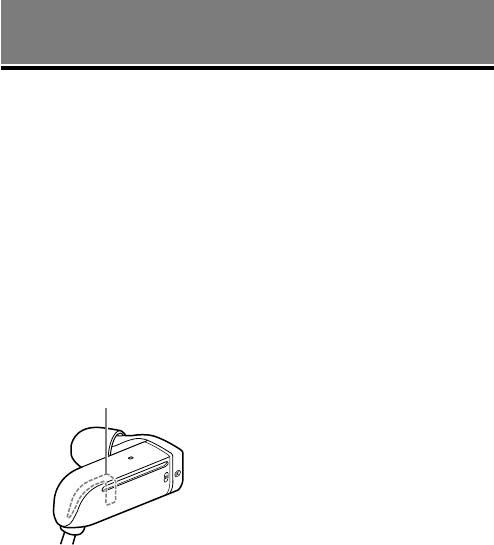
XBA-BT75 [US, ES] 4-411-333-11(1)
24
ES
INFORMACIÓN COMPLEMENTARIA
Precauciones
Comunicación Bluetooth
La tecnología inalámbrica Bluetooth
funciona en un rango de
aproximadamente 10 metros.
El rango máximo de comunicación puede
variar en función de los obstáculos
(personas, objetos metálicos, paredes, etc.)
o del entorno electromagnético.
La antena está incorporada en la unidad
como se muestra con la línea de puntos. La
sensibilidad de la comunicación Bluetooth
mejorará al girar la antena incorporada en
la unidad hacia el dispositivo Bluetooth
conectado.
La distancia de comunicación se reduce
cuando existen obstáculos entre la antena
del dispositivo conectado y esta unidad.
Ubicación de la
antena incorporada
Las condiciones siguientes pueden afectar
la sensibilidad de la comunicación
Bluetooth.
– La existencia de obstáculos como, por
ejemplo, una persona, un objeto
metálico o una pared entre esta unidad y
el dispositivo Bluetooth.
– El uso de dispositivos que utilicen una
frecuencia de 2,4 GHz como, por
ejemplo, un dispositivo LAN
inalámbrico, un teléfono inalámbrico o
un microondas cerca de la unidad.
Como los dispositivos Bluetooth y las LAN
inalámbricas (IEEE802.11b/g) utilizan la
misma frecuencia, pueden producirse
interferencias de microondas que
provoquen el deterioro de la velocidad de
la comunicación, la aparición de ruido o
una conexión no válida si la unidad se
utiliza cerca de un dispositivo LAN
inalámbrico. En este caso, realice el
procedimiento siguiente.
– Utilice esta unidad a una distancia
mínima de 10 m del dispositivo LAN
inalámbrico.
– Si utiliza esta unidad a menos de 10 m
de un dispositivo LAN inalámbrico,
apague el dispositivo LAN inalámbrico.
– Instale esta unidad y el dispositivo
Bluetooth a la distancia más corta
posible entre sí.
Las microondas que emite un dispositivo
Bluetooth pueden afectar el
funcionamiento de dispositivos médicos
electrónicos. Apague esta unidad y los
demás dispositivos Bluetooth en los lugares
siguientes, ya que podrían provocar un
accidente:
– donde exista gas inflamable, en un
hospital, tren, avión o gasolinera
– cerca de puertas automáticas o alarmas
de incendios
Esta unidad admite capacidades de
seguridad que cumplen con el estándar
Bluetooth para proporcionar una conexión
segura al utilizar la tecnología inalámbrica
Bluetooth, pero es posible que la seguridad
no sea suficiente según el ajuste. Tenga
cuidado al realizar una comunicación con
la tecnología inalámbrica Bluetooth.
No se aceptan responsabilidades por la
pérdida de información que pudiera
producirse durante una comunicación
Bluetooth.

XBA-BT75 [US, ES] 4-411-333-11(1)
25
ES
No se puede garantizar la conexión con
todos los dispositivos Bluetooth.
– Un dispositivo que disponga de la
función Bluetooth debe cumplir el
estándar Bluetooth especificado por
Bluetooth SIG, Inc. y estar autenticado.
– Incluso en el caso de que el dispositivo
conectado cumpla el estándar Bluetooth
mencionado anteriormente, es posible
que algunos dispositivos no puedan
conectarse o funcionar correctamente,
según las características o las
especificaciones del dispositivo.
– Mientras esté hablando con el manos
libre del teléfono, es posible que se
produzca ruido en función del
dispositivo o del entorno de
comunicación.
En función del dispositivo que vaya a
conectarse, es posible que transcurra cierto
tiempo antes de que se inicie la
comunicación.
Nota sobre electricidad estática
En condiciones de aire particularmente seco,
es posible que sienta un leve hormigueo en
las orejas. Esto se debe a la electricidad
estática acumulada en el cuerpo y no a una
falla de los auriculares. Puede reducir el
efecto si utiliza ropa fabricada con materiales
naturales.
Otros
No coloque esta unidad en lugares
expuestos a humedad, polvo, hollín, vapor
o la luz solar directa, ni la deje en un
automóvil en espera ante una señal de
tráfico. Se pueden producir fallas de
funcionamiento.
Es posible que el dispositivo Bluetooth no
funcione en teléfonos celulares
dependiendo del estado de las ondas de
radio y del lugar donde se utilice el equipo.
Si no se siente cómodo después de utilizar
el dispositivo Bluetooth, deje de utilizarlo
inmediatamente. Si el problema persiste,
consulte con el distribuidor Sony más
cercano.
Si usa la unidad a un volumen alto, puede
sufrir daños en los oídos. Por razones de
seguridad vial, no la utilice mientras
conduce o va en bicicleta.
No coloque ningún peso ni ejerza presión
sobre la unidad, ya que ésta podría
deformarse durante períodos de
almacenamiento prolongado.
No someta la unidad a golpes excesivos.
Limpie la unidad con un paño suave seco.
Cuando utilice la unidad, recuerde seguir
las precauciones siguientes para evitar
combar el receptáculo o provocar un fallo
de funcionamiento.
– Asegúrese de no sentarse con la unidad
en el bolsillo posterior.
– Asegúrese de no colocar la unidad en
una cartera con el sujetador envuelto en
la unidad, ya que es posible que un
impacto accidental dañe la unidad.
No exponga la unidad al agua. La unidad
no es impermeable.
Recuerde seguir las precauciones
siguientes.
– Tenga cuidado de no dejar caer la
unidad en un fregadero u otro recipiente
que contenga agua.
– No utilice la unidad en lugares húmedos
o si hace mal tiempo, por ejemplo, si
llueve o nieva.
Continúa
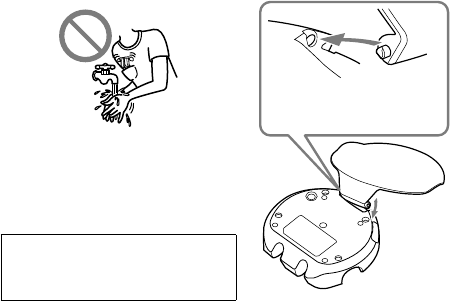
XBA-BT75 [US, ES] 4-411-333-11(1)
26
ES
– No deje que la unidad se moje.
Si toca la unidad con las manos mojadas,
o la coloca en una prenda de ropa
mojada, la unidad se puede mojar y esto
puede provocar un funcionamiento
incorrecto de la misma.
Si desea realizar alguna consulta o
solucionar algún problema relativo a la
unidad que no se trate en este manual,
póngase en contacto con el distribuidor
Sony más cercano a su domicilio.
Puede solicitar almohadillas de
reemplazo opcionales al minorista de
Sony autorizado más cercano o en el sitio
web www.sony.com.
Si la tapa se separa del estuche de
transporte
Vuelva a colocar la tapa en el estuche
de transporte, tal como se muestra en
la imagen.
Coloque el pasador en
un lado.
Aplique
presión sobre
el otro lado
para ajustar la
tapa.
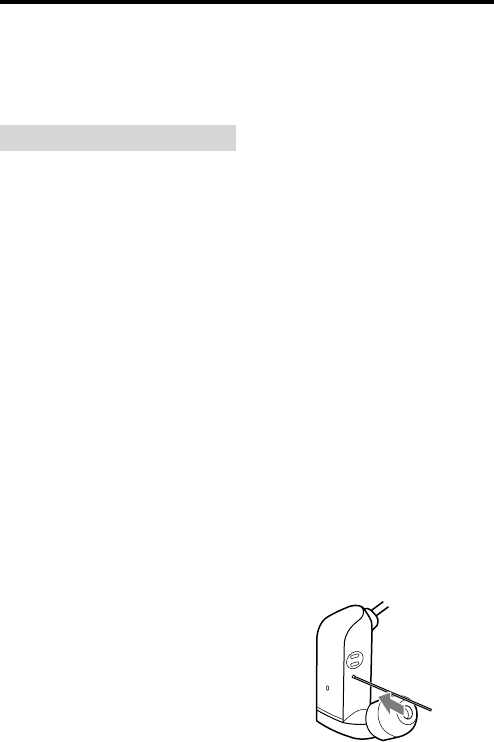
XBA-BT75 [US, ES] 4-411-333-11(1)
27
ES
Solución de problemas
Si tiene dificultades para utilizar esta unidad, sírvase de la siguiente lista de
comprobaciones y consulte la información de ayuda del producto en nuestro sitio
Web.
Si el problema persiste, consulte con el distribuidor Sony más cercano.
Común
La unidad no está encendida.
Cargue la batería de la unidad. Cuando
no use la unidad durante un largo
período de tiempo, cargue la batería
recargable al menos dos veces por año
para evitar el deterioro de la batería.
No es posible encender los auriculares
mientras se están cargando. Quite el
cable USB y los auriculares del estuche
de transporte y luego encienda los
auriculares.
No se puede llevar a cabo el
emparejamiento.
Acerque esta unidad y el dispositivo
Bluetooth entre sí.
No se realizó la conexión
Bluetooth.
Compruebe que la unidad está
encendida.
Compruebe que el dispositivo Bluetooth
que desea conectar está encendido y que
la función Bluetooth está activada.
Es posible que la unidad no memorice la
conexión con el dispositivo Bluetooth.
Realice la conexión Bluetooth del
dispositivo Bluetooth a la unidad
inmediatamente después de finalizar el
emparejamiento.
Esta unidad o el dispositivo Bluetooth
que desea conectar está en modo en
espera.
Se completó la conexión Bluetooth.
Realice la conexión Bluetooth de nuevo
(para escuchar música: consulte la
página 18 y para la realización de
llamadas: consulte la página 20).
El sonido aparece
distorsionado.
Asegúrese de que la unidad no está
recibiendo interferencias de una red
LAN inalámbrica, de algún otro
dispositivo inalámbrico de 2,4 GHz ni
de un microondas.
La distancia de
correspondencia es demasiado
corta. (Se producen saltos del
sonido).
Si hay cerca un dispositivo que genera
radiación electromagnética como, por
ejemplo, una LAN inalámbrica, otro
dispositivo Bluetooth o un microondas,
aleje la unidad de estas fuentes.
Oriente la antena de la unidad (página
24) hacia el dispositivo Bluetooth.
Asegúrese de que ningún obstáculo
bloquea la comunicación.
La unidad no funciona
correctamente.
Reinicie la unidad. La información de
emparejamiento no se borra con esta
operación.
Inserte un pequeño pasador, etc., en el
orificio con cierto ángulo y empuje hasta
escuchar un chasquido.

XBA-BT75 [US, ES] 4-411-333-11(1)
28
ES
Durante la carga
No es posible llevar a cabo la
carga.
Compruebe que el estuche de transporte
y la computadora están firmemente
conectados mediante el cable USB.
Controle que los auriculares estén
colocados correctamente en el estuche
de transporte.
Controle que la tapa del estuche de
transporte esté cerrada firmemente.
Compruebe que la computadora está
encendida.
Compruebe que la computadora no se
encuentra en el modo de espera,
suspensión o hibernación.
Si carga la unidad con un adaptador de
alimentación de ca, asegúrese de usar el
adaptador de alimentación de ca de
carga USB AC-U501AD recomendado
(se vende por separado).
El tiempo de carga se prolonga
demasiado.
Compruebe que el estuche de transporte
y la computadora estén conectados
directamente (no a través de un
concentrador USB).
La computadora no reconoce
al estuche de transporte.
El cable USB no está conectado
correctamente al puerto USB de la
computadora. Conecte el cable USB de
nuevo.
Compruebe que el estuche de transporte
y la computadora estén conectados
directamente (no a través de un
concentrador USB).
Es posible que se produzca un problema
con el puerto USB conectado de la
computadora. Realice la conexión a otro
puerto USB si está disponible.
Realice el procedimiento de conexión
USB de nuevo en los casos que no sean
los mencionados anteriormente.
Al escuchar música
No hay sonido
Compruebe que el dispositivo Bluetooth
está encendido.
No se pudo establecer la conexión
Bluetooth A2DP entre la unidad y el
dispositivo Bluetooth. Realice una
conexión Bluetooth A2DP (página 18).
Compruebe que se reproduce música en
el dispositivo Bluetooth.
Compruebe que el volumen de la unidad
no está demasiado bajo.
Si es necesario, suba el volumen del
dispositivo conectado.
Vuelva a emparejar la unidad y el
dispositivo Bluetooth (página 13).
El nivel del sonido es bajo
Suba el volumen de la unidad.
Si es necesario, suba el volumen del
dispositivo conectado.
Sonido de baja calidad
Cambie la conexión Bluetooth a A2DP al
utilizar el dispositivo Bluetooth cuando
la función HSP está configurada.
Se producen saltos frecuentes
en el sonido durante la
reproducción.
Es posible que la recepción de la unidad
se haya vuelto inestable debido a que los
ajustes de la velocidad de bits de la
música transmitida no corresponden a
los del dispositivo Bluetooth y el entorno
en que se utiliza la unidad.*1
Finalice la conexión Bluetooth A2DP
mediante el dispositivo Bluetooth. Si la
unidad está apagada, mantenga
presionado el botón – y el botón
(multifunción) durante
aproximadamente dos segundos.
Después de que el indicador parpadea de
color rojo (que indica que queda carga)
y una vez de color azul, suelte los
botones. La unidad se enciende y la
configuración de “Sound Quality”
(Calidad del sonido) se cambia a
“Standard” (Estándar). Disminuye la
configuración de la velocidad de bits
recibidos.*2
*1 La velocidad de bits es un valor
numérico que expresa el volumen de
transmisión de datos por segundo.
Como norma general, cuanto más
alta sea la velocidad de bits, mejor
será la calidad del sonido. Esta unidad

XBA-BT75 [US, ES] 4-411-333-11(1)
29
ES
Inicialización de la
unidad
Puede restablecer la unidad a la
configuración predeterminada (así
como el volumen) y eliminar la
información de emparejamiento.
1 Si la unidad está apagada,
mantenga presionado el botón
(multifunción) durante 15
segundos o más.
El indicador (azul) se enciende si
presiona el botón durante 10
segundos o más y parpadea 4 veces
si presiona el botón durante 15
segundos o más. La unidad se
restablece a los ajustes
predeterminados. Toda la
información de emparejamiento se
elimina.
está preparada para recibir música
con una alta velocidad de bits; no
obstante, es posible que se produzcan
saltos en el sonido en función del
entorno en que se utilice.
*2 En función del entorno en que se
utilice la unidad, es posible que las
operaciones anteriores no reduzcan
los saltos en el sonido. Para volver a
configurar “Sound Quality” (Calidad
de sonido) en “High Quality”
(Calidad alta), si la unidad está
apagada, mantenga presionados el
botón + y el botón (multifunción)
durante aproximadamente dos
segundos. Una vez que el indicador
parpadee de color rojo (que indica
que queda carga) y dos veces de color
azul, suelte los botones.
Durante la realización de
llamadas
No se escucha la voz del
destinatario de la llamada.
Compruebe que tanto la unidad como el
teléfono celular Bluetooth están
encendidos.
Compruebe la conexión de la unidad
con el teléfono celular Bluetooth. Vuelva
a realizar una conexión Bluetooth (HFP
o HSP) (página 20).
Compruebe que la salida del teléfono
celular Bluetooth está ajustada para esta
unidad.
Compruebe que el volumen de la unidad
no está demasiado bajo.
Si es necesario, aumente el volumen del
teléfono celular Bluetooth conectado.
Si escucha música en la unidad, detenga
la reproducción, presione el botón
(multifunción) y hable.
El sonido del destinatario de la
llamada es bajo
Suba el volumen de la unidad.
Si es necesario, aumente el volumen del
teléfono celular Bluetooth conectado.

XBA-BT75 [US, ES] 4-411-333-11(1)
30
ES
Especificaciones
Generales
Sistema de comunicación
Especificación Bluetooth versión 3.0
Salida
Clase de potencia 2 de especificación
Bluetooth
Rango de comunicación máximo
Línea de vista de aprox. 10 m*1
Banda de frecuencia
Banda de 2,4 GHz (2,4000 GHz -
2,4835 GHz)
Método de modulación
FHSS
Perfiles Bluetooth compatibles*2
A2DP (Advanced Audio Distribution
Profile)
AVRCP (Audio Video Remote Control
Profile)
HFP (Hands-free Profile)
HSP (Headset Profile)
Códec compatible*3
SBC*4
Sistema de protección de contenido
admitido
SCMS-T
Intervalo de transmisión (A2DP)
20 Hz - 20.000 Hz (frecuencia de muestreo
de 44,1 kHz)
Artículos incluidos
Auriculares (1)
Estuche de transporte de batería incorporado
(1)
Almohadillas S (2), M (2), L (2)
Cable USB (1)
Bolsa de transporte (1)
Manual de instrucciones (este documento)
(1)
Accesorio recomendado
Adaptador de alimentación de ca de carga
USB:
AC-U501AG (se vende por separado)
*1 El rango real variará en función de
factores como, por ejemplo, los obstáculos
que puedan interponerse entre los
dispositivos, los campos magnéticos que
puedan existir en torno a hornos
microondas, la electricidad estática, la
sensibilidad de recepción o el rendimiento
de la antena, del sistema operativo, de la
aplicación de software, etc.
*2 Los perfiles estándar Bluetooth indican la
finalidad de la comunicación Bluetooth
entre dispositivos.
*3 Códec: formato de conversión y
compresión de señales de audio
*4 Códec de banda secundaria

XBA-BT75 [US, ES] 4-411-333-11(1)
31
ES
Auriculares estéreo
inalámbricos
Fuente de alimentación
cc de 3,7 V: batería recargable de iones de
litio incorporada
Masa
Aprox. 21 g
Temperatura de funcionamiento
De 5 ºC a 35 ºC
Receptor
Tipo
Cerrado, armadura balanceada
Unidades auriculares
Armadura balanceada
Respuesta de frecuencia
14 Hz – 24.000 Hz
Micrófono
Tipo
MEMS
Características de dirección
Omnidireccional
Gama de frecuencias efectivas
100 Hz – 4.000 Hz
Requisitos del sistema
para realizar la carga de
la batería a través de
USB
Ordenador con puerto USB y alguno de los
siguientes sistemas operativos instalados
previamente:
Sistemas operativos
(con Windows)
Windows® 7
Starter / Home Basic / Home Premium /
Professional / Ultimate
Windows Vista® (Service Pack 2 o posterior)
Home Basic / Home Premium / Business /
Ultimate
Windows® XP (Service Pack 3 o posterior)
Home Edition / Professional / Media Center
Edition 2004 / Media Center Edition 2005
(con Macintosh)
Mac OS X (versión.10.3 o posterior)
El diseño y las especificaciones están sujetos
a cambios sin previo aviso.

XBA-BT75 [US, ES] 4-411-333-11(1)
©2011 Sony Corporation
Printed in China